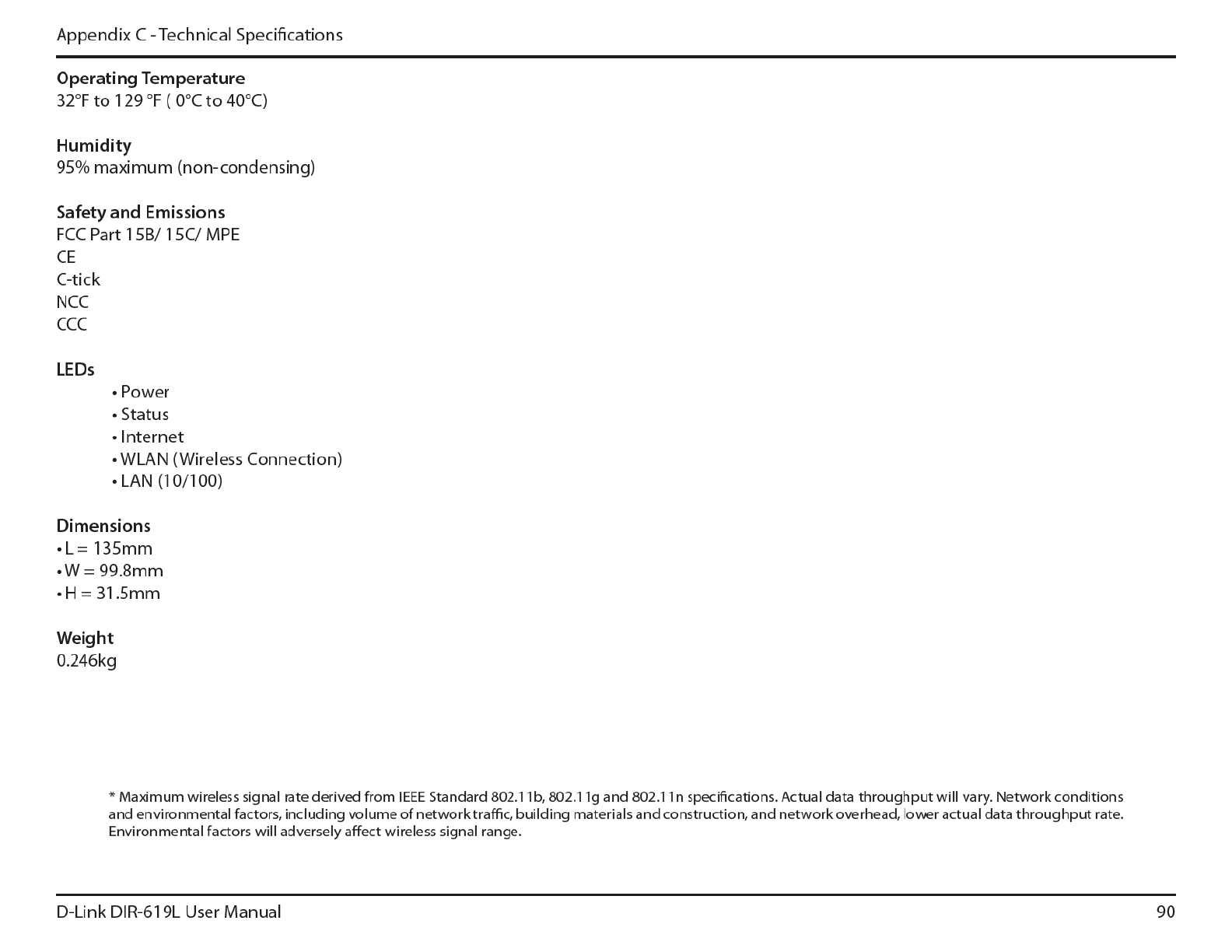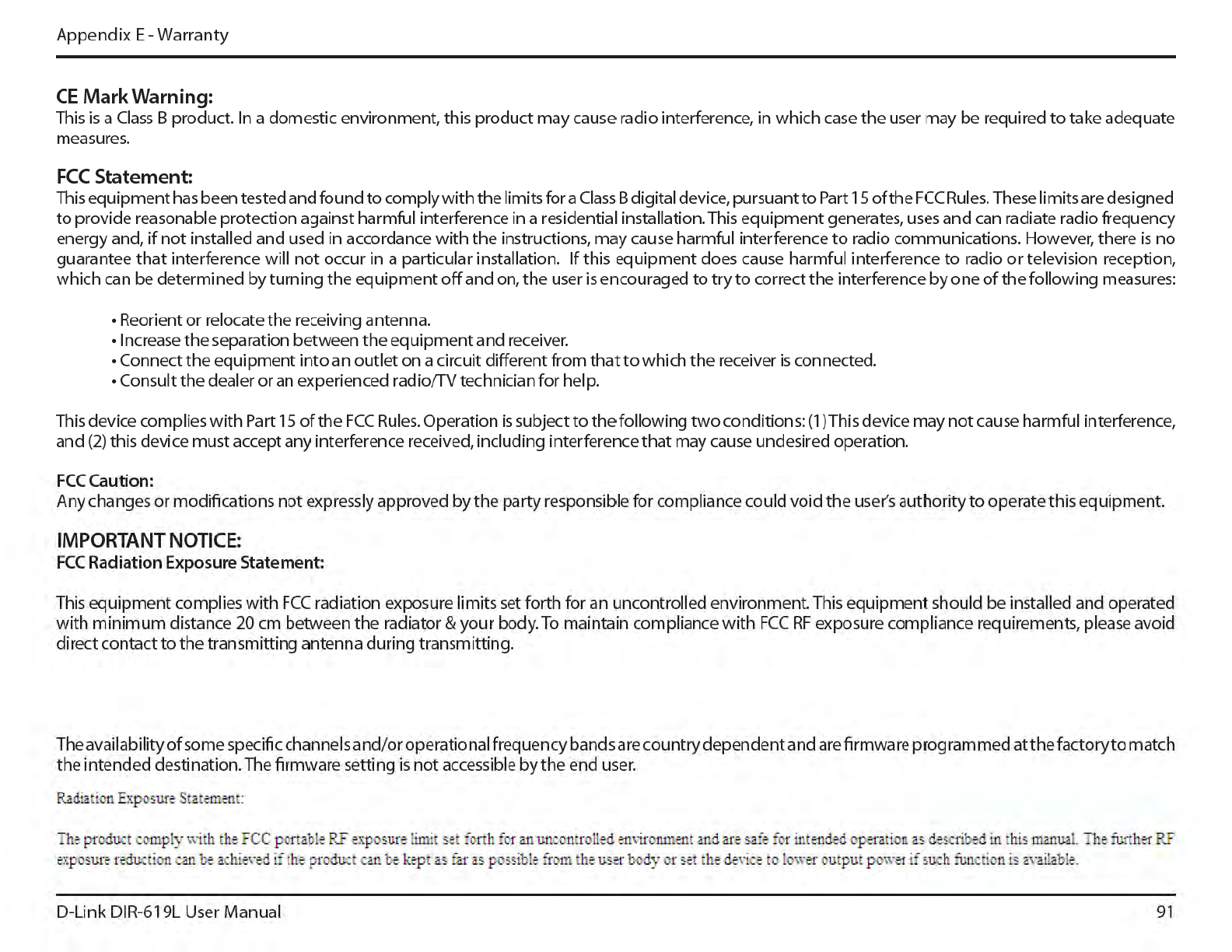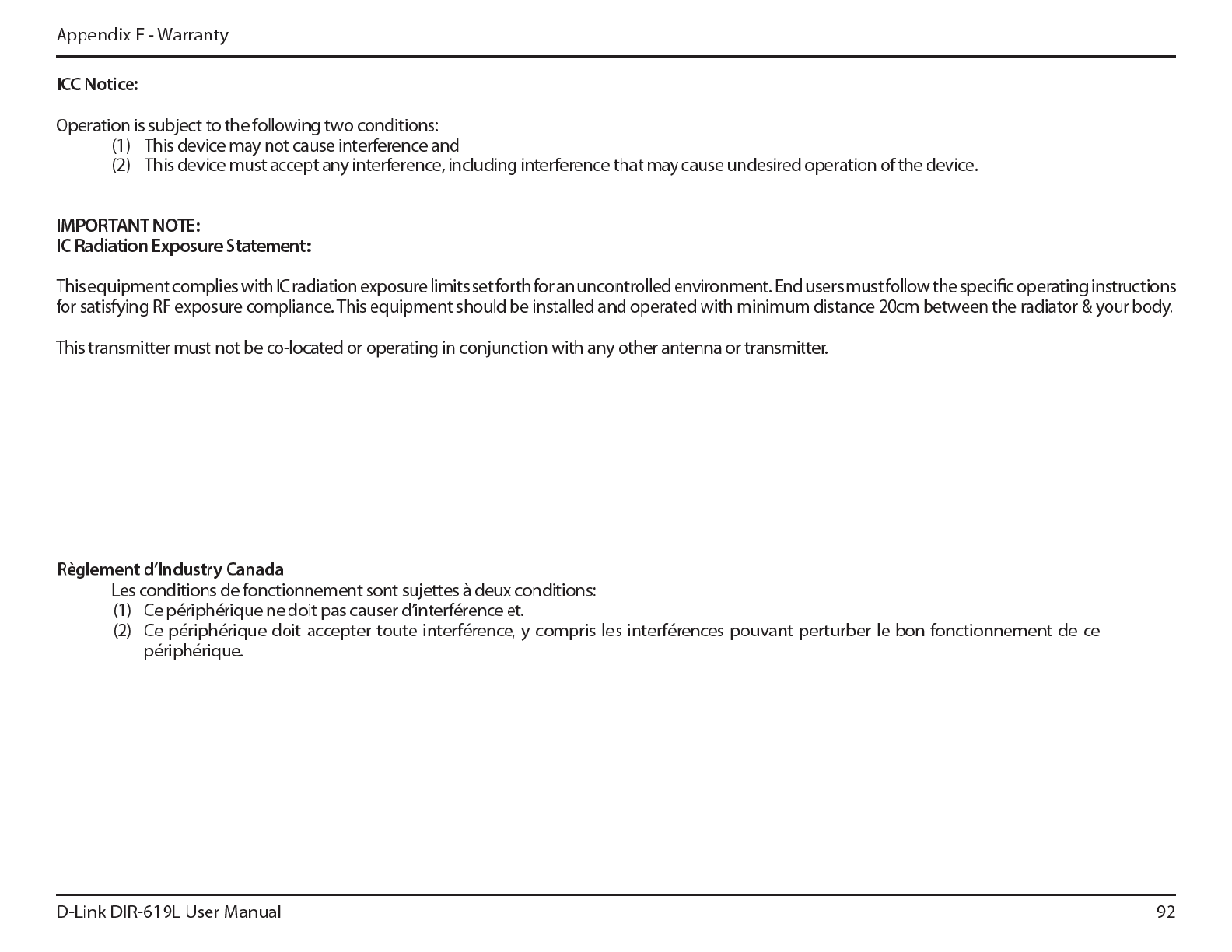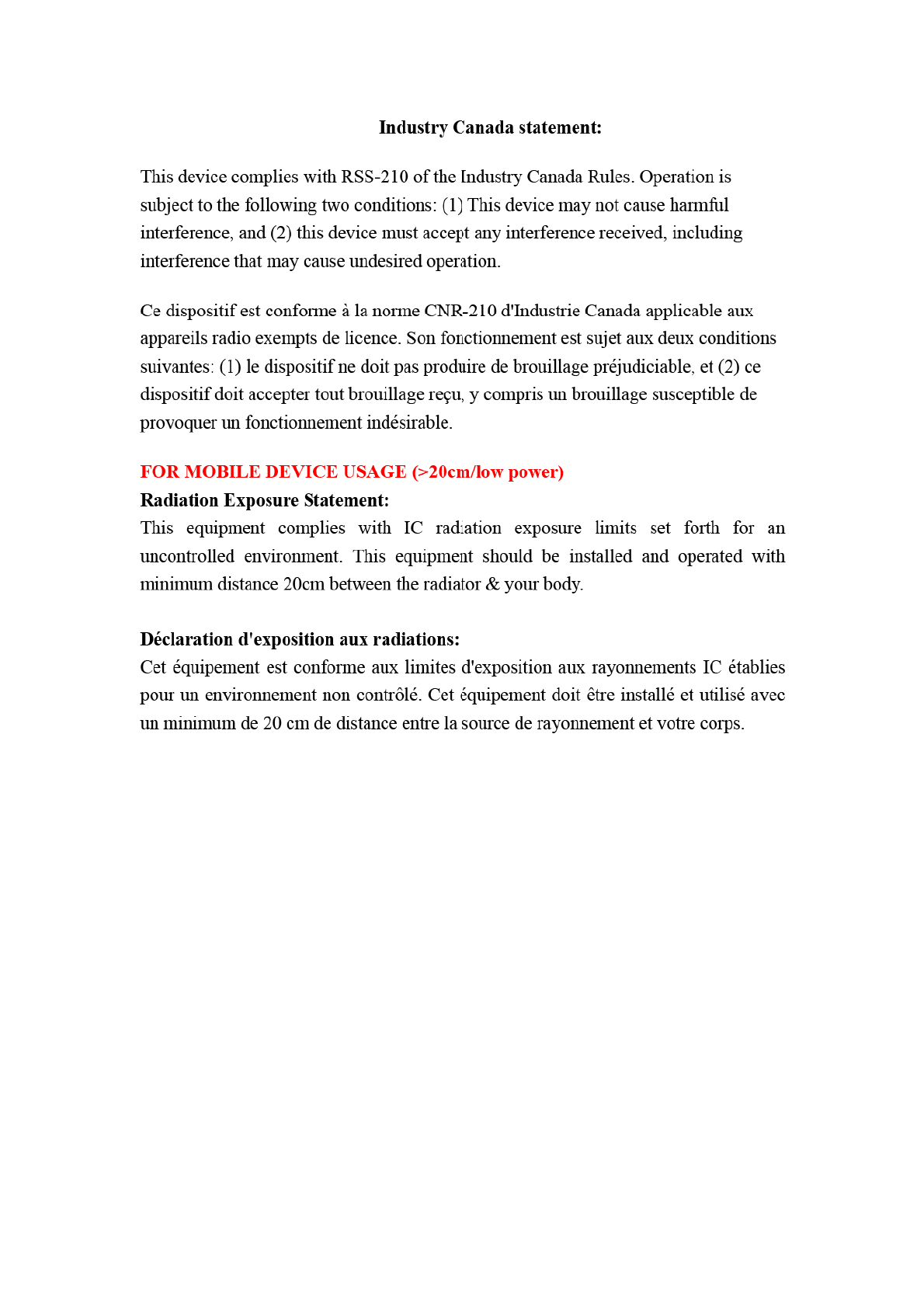D Link IR619LB1 Wireless N 300 Cloud Router User Manual IC Statement bgn
D Link Corporation Wireless N 300 Cloud Router IC Statement bgn
D Link >
Contents
- 1. User Manual Part 1.pdf
- 2. User Manual Part 2.pdf
User Manual Part 2.pdf
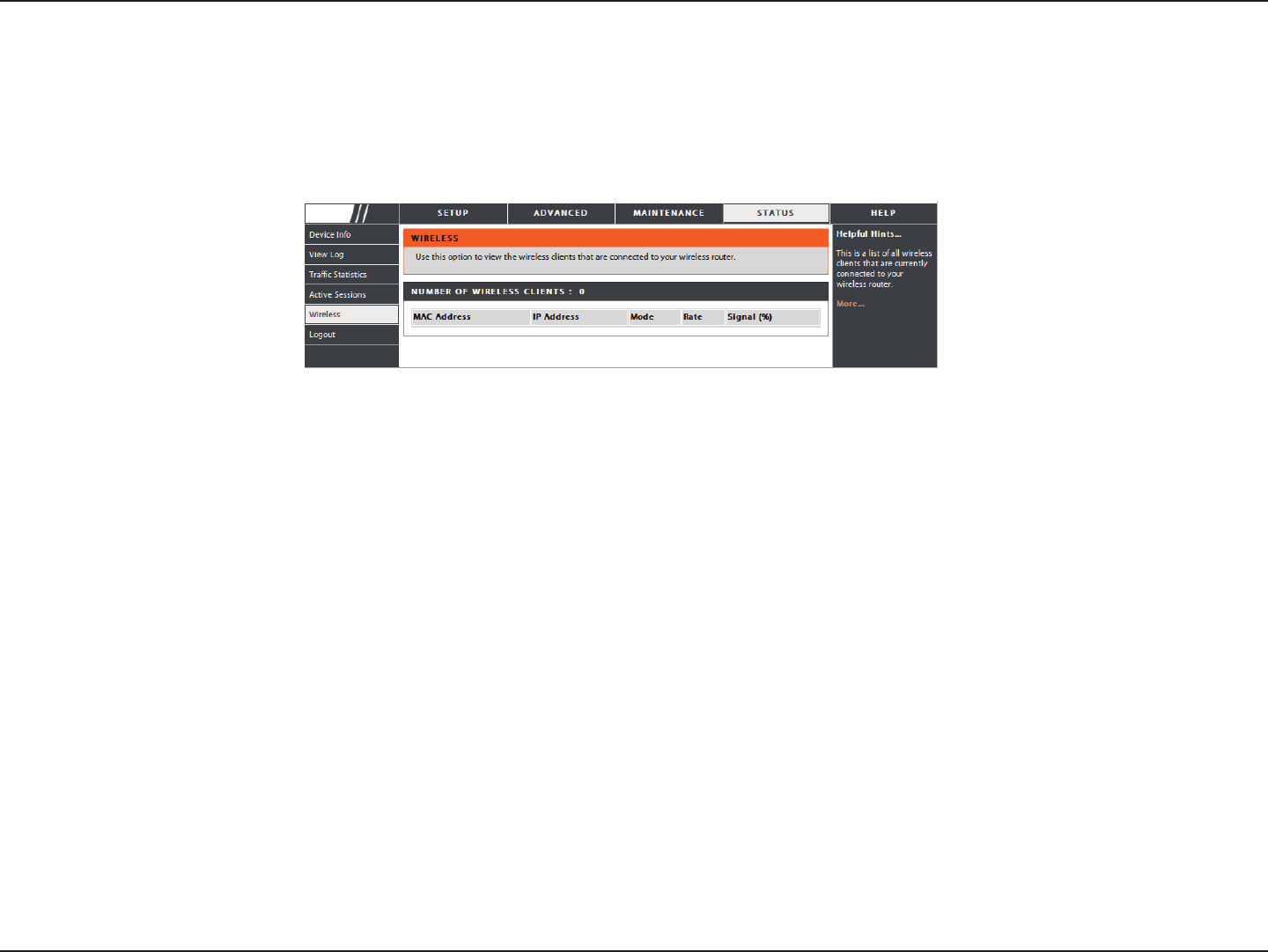
45D-Link DIR-619L User Manual
Section 3 - Conguration
Wireless
The wireless client table displays a list of current connected wireless clients. This table also displays the connection time and
MAC address of the connected wireless client.
DIR-619L
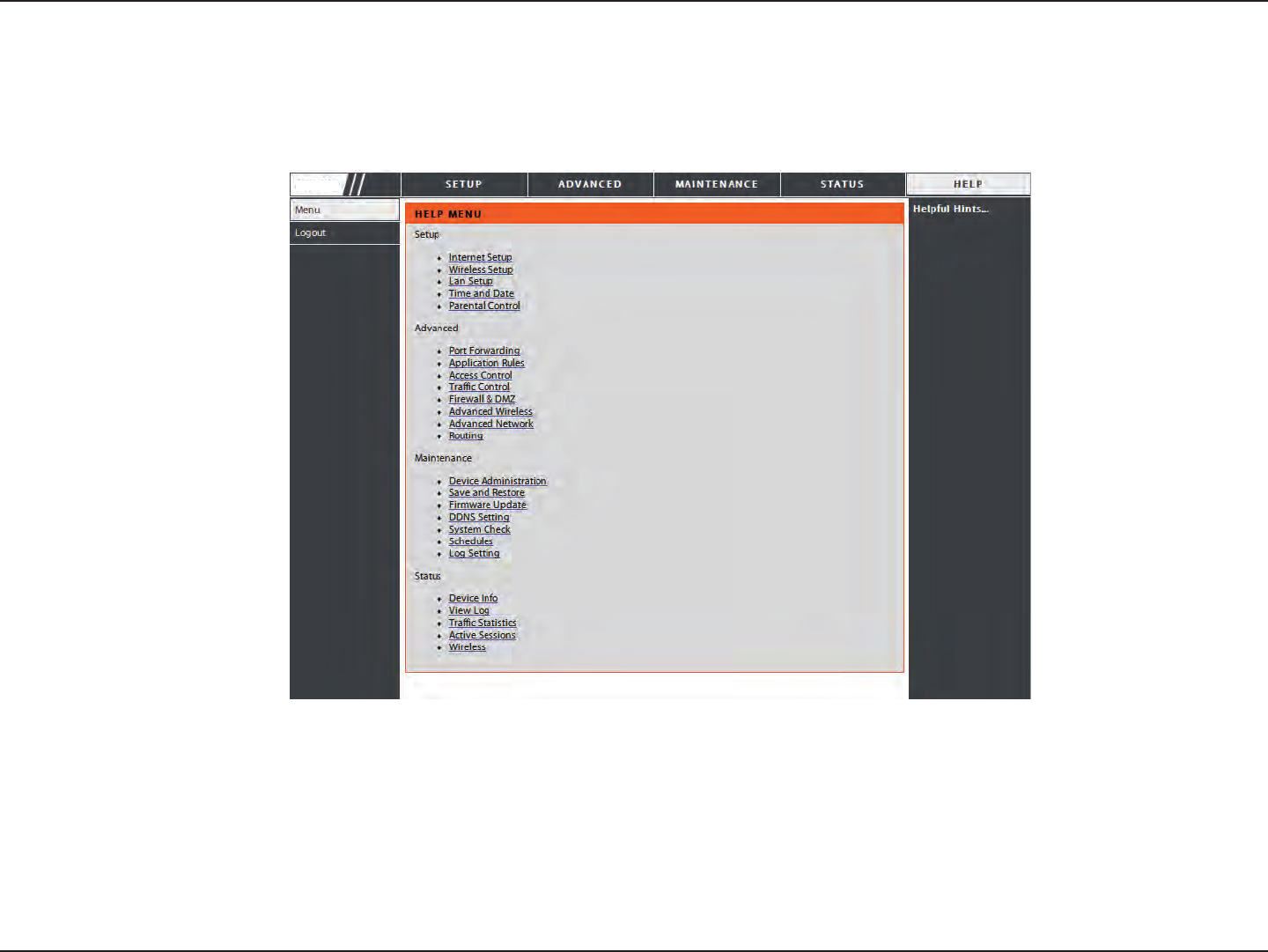
46D-Link DIR-619L User Manual
Section 3 - Conguration
Help
Click the desired hyperlink to get more information about how to use the Router.
DIR-619L

47D-Link DIR-619L User Manual
Section 4 - Security
Wireless Security
This section will show you the dierent levels of security you can use to protect your data from intruders. The
DIR-619L oers the following types of security:
• WPA2 (Wi-Fi Protected Access 2) • WPA2-PSK (Pre-Shared Key)
• WPA (Wi-Fi Protected Access) • WPA-PSK (Pre-Shared Key)
• WEP (Wired Equivalent Privacy)
What is WEP?
WEP stands for Wired Equivalent Privacy. It is based on the IEEE 802.11 standard and uses the RC4 encryption algorithm. WEP
provides security by encrypting data over your wireless network so that it is protected as it is transmitted from one wireless
device to another.
To gain access to a WEP network, you must know the key. The key is a string of characters that you create. When using WEP,
you must determine the level of encryption. The type of encryption determines the key length. 128-bit encryption requires a
longer key than 64-bit encryption. Keys are dened by entering in a string in HEX (hexadecimal - using characters 0-9, A-F) or
ASCII (American Standard Code for Information Interchange – alphanumeric characters) format. ASCII format is provided so
you can enter a string that is easier to remember. The ASCII string is converted to HEX for use over the network. Four keys can
be dened so that you can change keys easily.
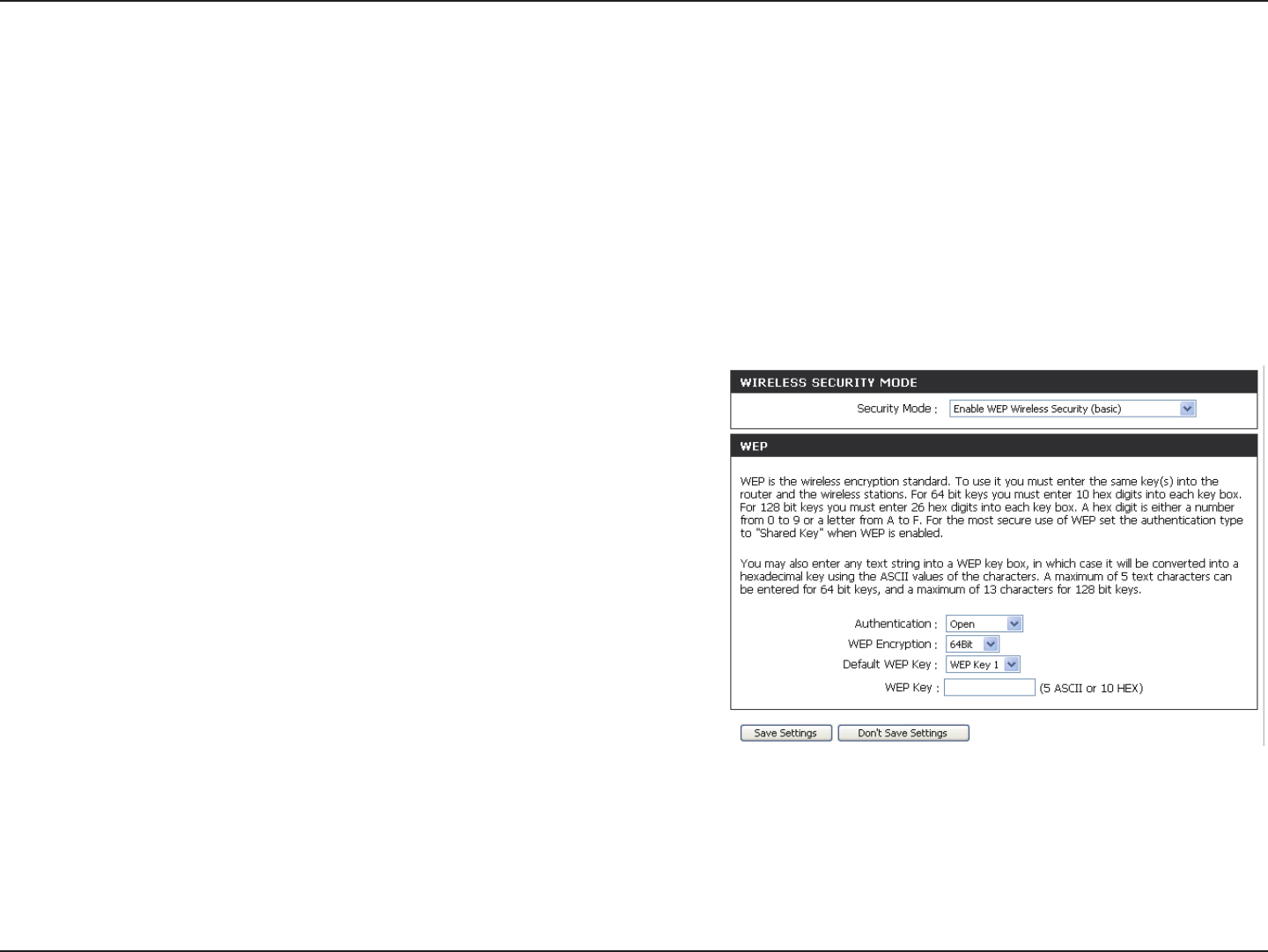
48D-Link DIR-619L User Manual
Section 4 - Security
Congure WEP
It is recommended to enable encryption on your wireless router before your wireless network adapters. Please establish
wireless connectivity before enabling encryption. Your wireless signal may degrade when enabling encryption due to the
added overhead.
1. Log into the web-based conguration by opening a web browser and entering the IP address of the router (192.168.0.1).
Click on Wireless Setup on the left side.
2. Next to Security Mode, select Enable WEP Wireless Security (basic).
3. Next to Authentication, select either Shared Key or Open. Shared Key
is recommended as it provides greater security when WEP is enabled.
4. Select either 64Bit or 128Bit encryption from the drop-down menu
next to WEP Encryption.
5. Next to Default Key Type, select WEP Key 1 and enter a WEP key that
you create. Make sure you enter this key exactly on all your wireless
devices. You may enter up to four dierent keys either using Hex or
ASCII. Hex is recommended (letters A-F and numbers 0-9 are valid). In
ASCII all numbers and letters are valid.
6. Click Save Settings to save your settings. If you are conguring the
router with a wireless adapter, you will lose connectivity until you
enable WEP on your adapter and enter the same WEP key as you did on the router.

49D-Link DIR-619L User Manual
Section 4 - Security
What is WPA?
WPA, or Wi-Fi Protected Access, is a Wi-Fi standard that was designed to improve the security features of WEP (Wired Equivalent
Privacy).
The two major improvements over WEP:
• Improved data encryption through the Temporal Key Integrity Protocol (TKIP). TKIP scrambles the keys using a
hashing algorithm and, by adding an integrity-checking feature, ensures that the keys haven’t been tampered
with. WPA2 is based on 802.11i and uses Advanced Encryption Standard (AES) instead of TKIP.
• User authentication, which is generally missing in WEP, through the extensible authentication protocol (EAP).
WEP regulates access to a wireless network based on a computer’s hardware-specic MAC address, which is
relatively simple to be snied out and stolen. EAP is built on a more secure public-key encryption system to
ensure that only authorized network users can access the network.
WPA-PSK/WPA2-PSK uses a passphrase or key to authenticate your wireless connection. The key is an alpha-numeric password
between 8 and 63 characters long. The password can include symbols (!?*&_) and spaces. This key must be the exact same key
entered on your wireless router or access point.
WPA/WPA2 incorporates user authentication through the Extensible Authentication Protocol (EAP). EAP is built on a more
secure public key encryption system to ensure that only authorized network users can access the network.
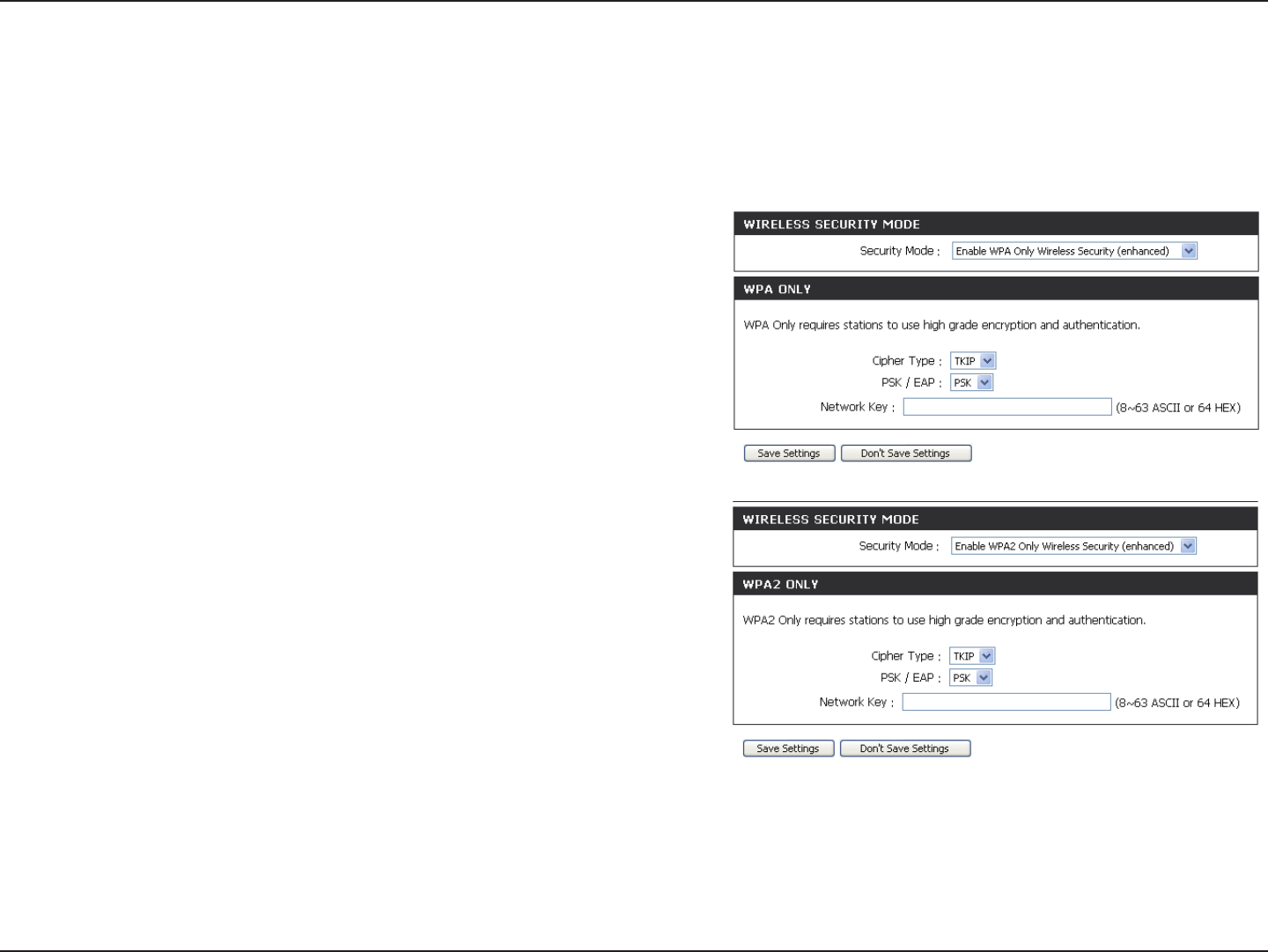
50D-Link DIR-619L User Manual
Section 4 - Security
Congure WPA-PSK and WPA2-PSK
It is recommended to enable encryption on your wireless Router before your wireless network adapters. Please establish
wireless connectivity before enabling encryption. Your wireless signal may degrade when enabling encryption due to the
added overhead.
1. Log into the web-based conguration by opening a web browser and
entering the IP address of the router (192.168.0.1). Click on Wireless
Setup on the left side.
2. Next to Security Mode, select Enable WPA Only Wireless Security
(enhanced) or Enable WPA2 Only Wireless Security (enhanced).
3. Next to Cipher Mode, select TKIP, AES, or Both.
4. Next to PSK/EAP, select PSK.
5. Next to Network Key, enter a key (passphrase). The key is an alpha-
numeric password
between 8 and 63 characters long. The password can
include symbols (!?*&_) and spaces. Make sure you enter
this key exactly the same on all other wireless clients.
6. Click Save Settings to save your settings. If you are conguring the
Router with a wireless adapter, you will lose connectivity until you
enable WPA-PSK or WPA2-PSK on your adapter and enter the same passphrase as you did on the Router.
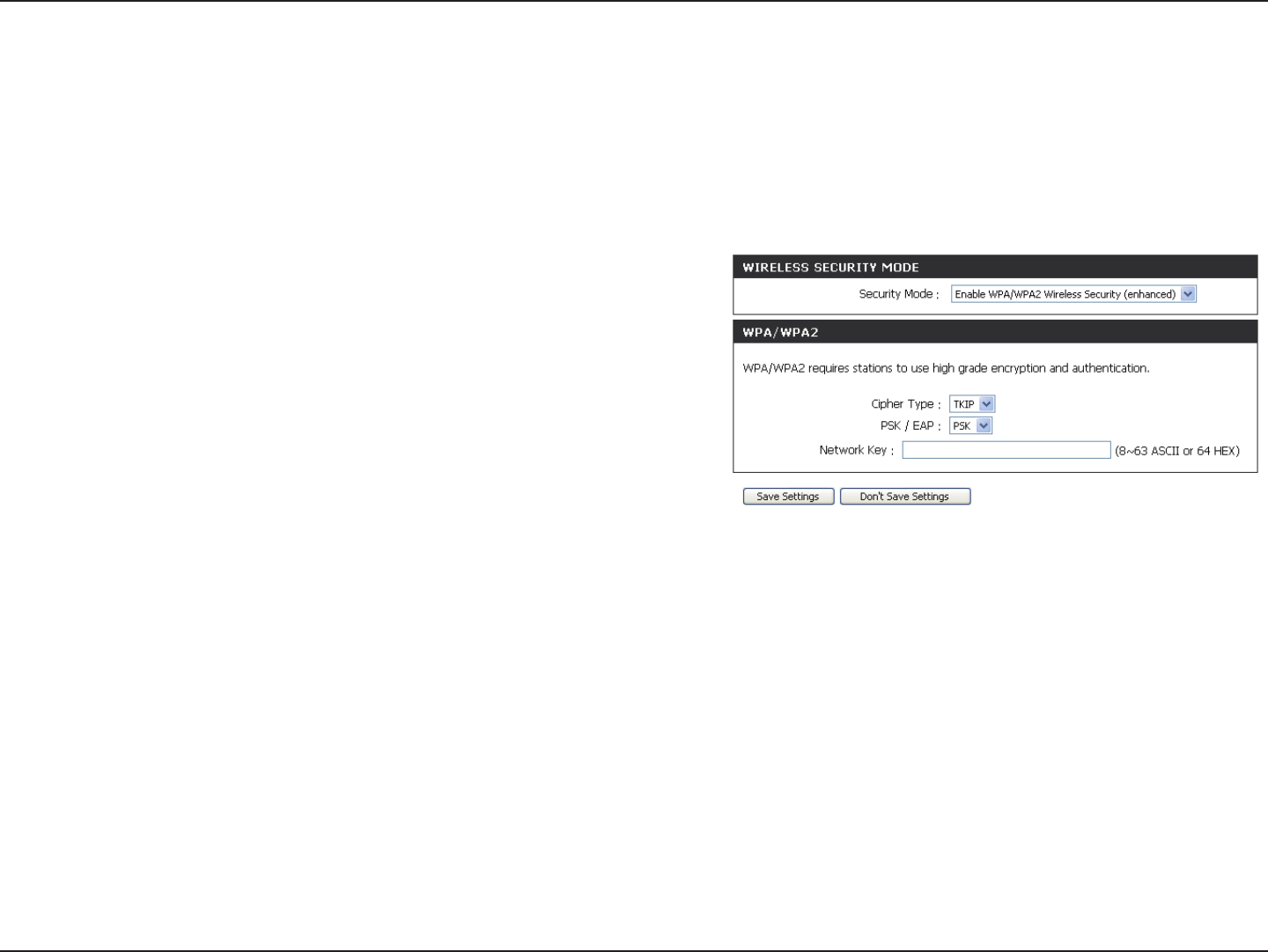
51D-Link DIR-619L User Manual
Section 4 - Security
Congure WPA/WPA2-PSK
It is recommended to enable encryption on your wireless Router before your wireless network adapters. Please establish
wireless connectivity before enabling encryption. Your wireless signal may degrade when enabling encryption due to the
added overhead.
1. Log into the web-based conguration by opening a web browser and
entering the IP address of the router (192.168.0.1). Click on Wireless
Setup on the left side.
2. Next to Security Mode, select Enable WPA/WPA2 Wireless Security
(enhanced).
3. Next to Cipher Mode, select TKIP, AES, or Both.
4. Next to PSK/EAP, select PSK.
5. Next to Network Key, enter a key (passphrase). The key is an alpha-numeric password
between 8 and 63 characters long. The password can include symbols (!?*&_) and spaces.
Make sure you enter this key exactly the same on all other wireless clients.
6. Click Save Settings to save your settings. If you are conguring the Router with a wireless adapter, you will lose connectivity
until you enable WPA/WPA2-PSK on your adapter and enter the same passphrase as you did on the Router.
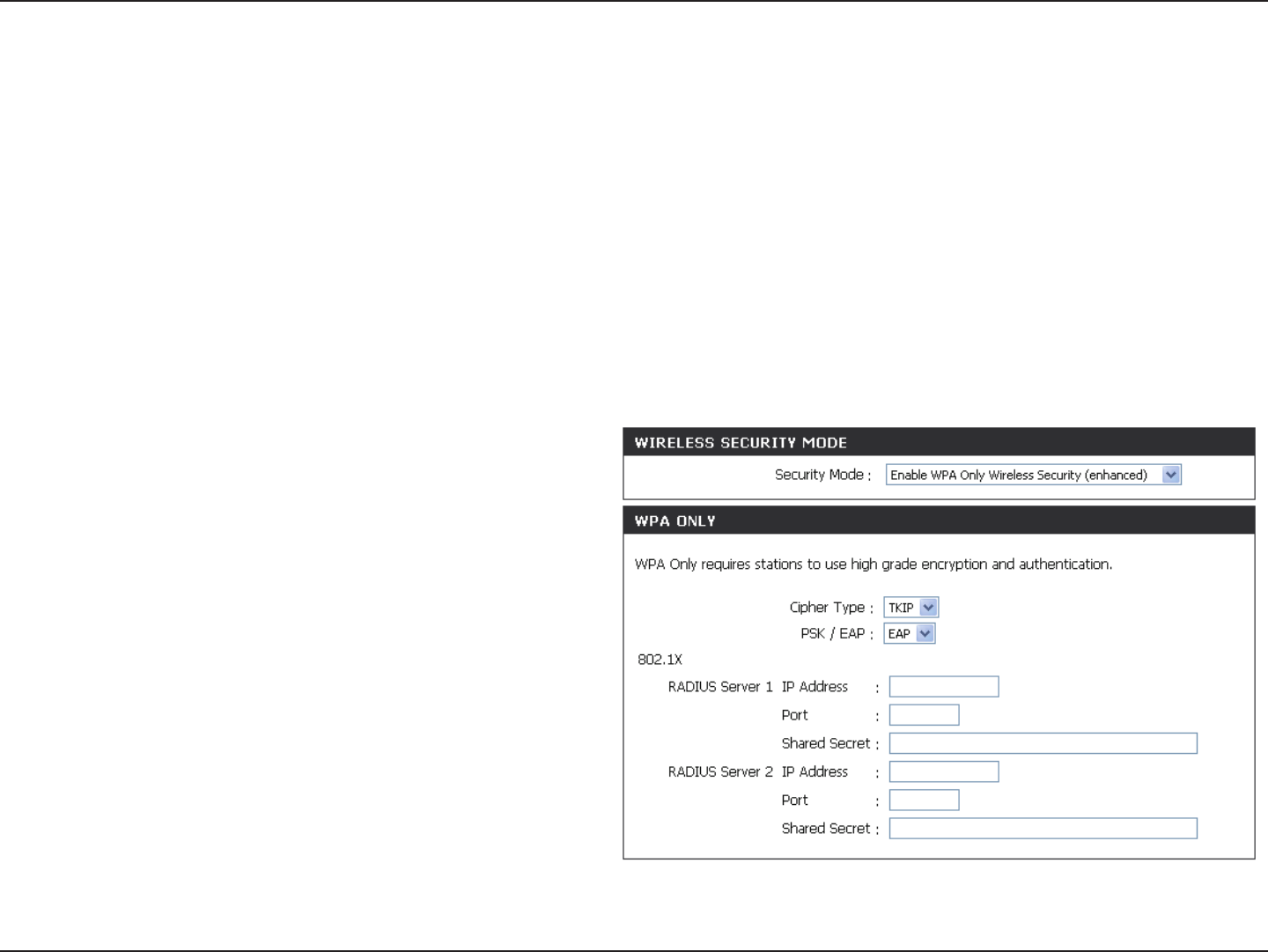
52D-Link DIR-619L User Manual
Section 4 - Security
Congure WPA, WPA2, and WPA/WPA2 (RADIUS)
It is recommended to enable encryption on your wireless router before your wireless network adapters. Please establish
wireless connectivity before enabling encryption. Your wireless signal may degrade when enabling encryption due to the
added overhead.
1. Log into the web-based conguration by opening a web browser and entering the IP address of the router (192.168.0.1).
Click on Wireless Settings on the left side.
2. Next to Security Mode, select Enable WPA Only Wireless Security (enhanced), Enable WPA2 Only Wireless Security (enhanced),
or Enable WPA/WPA2 Wireless Security (enhanced).
3. Next to Cipher Type, select TKIP, AES, or Auto.
4. Next to PSK/EAP, select EAP.
5. Next to RADIUS Server 1 enter the IP Address of your
RADIUS server.
6. Next to Port, enter the port you are using with your
RADIUS server. 1812 is the default port.
7. Next to Shared Secret, enter the security key.
8. If you have a secondary RADIUS server, enter its IP address,
port, and secret key.
9. Click Save Settings to save your settings.
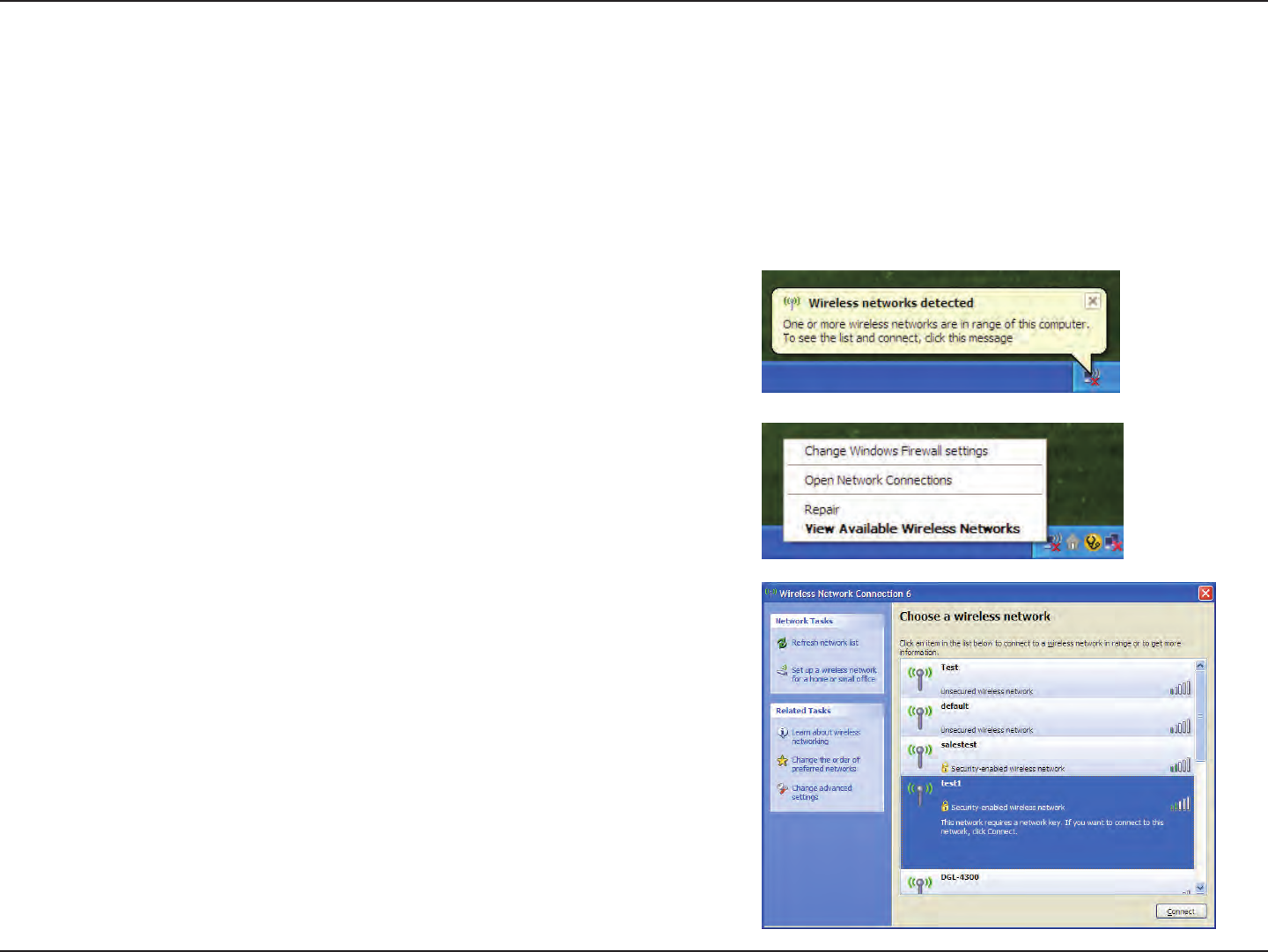
53D-Link DIR-619L User Manual
Section 5 - Connecting to a Wireless Network
Connect to a Wireless Network
Using Windows® XP
Windows® XP users may use the built-in wireless utility (Zero Conguration Utility). The following instructions are for Service
Pack 2 users. If you are using another company’s utility or Windows® 2000, please refer to the user manual of your wireless
adapter for help with connecting to a wireless network. Most utilities will have a “site survey” option similar to the Windows®
XP utility as seen below.
Right-click on the wireless computer icon in your system tray
(lower-right corner next to the time). Select View Available
Wireless Networks.
If you receive the Wireless Networks Detected bubble, click on
the center of the bubble to access the utility.
or
The utility will display any available wireless networks in your area.
Click on a network (displayed using the SSID) and click the Connect
button.
If you get a good signal but cannot access the Internet, check you
TCP/IP settings for your wireless adapter. Refer to the Networking
Basics section in this manual for more information.
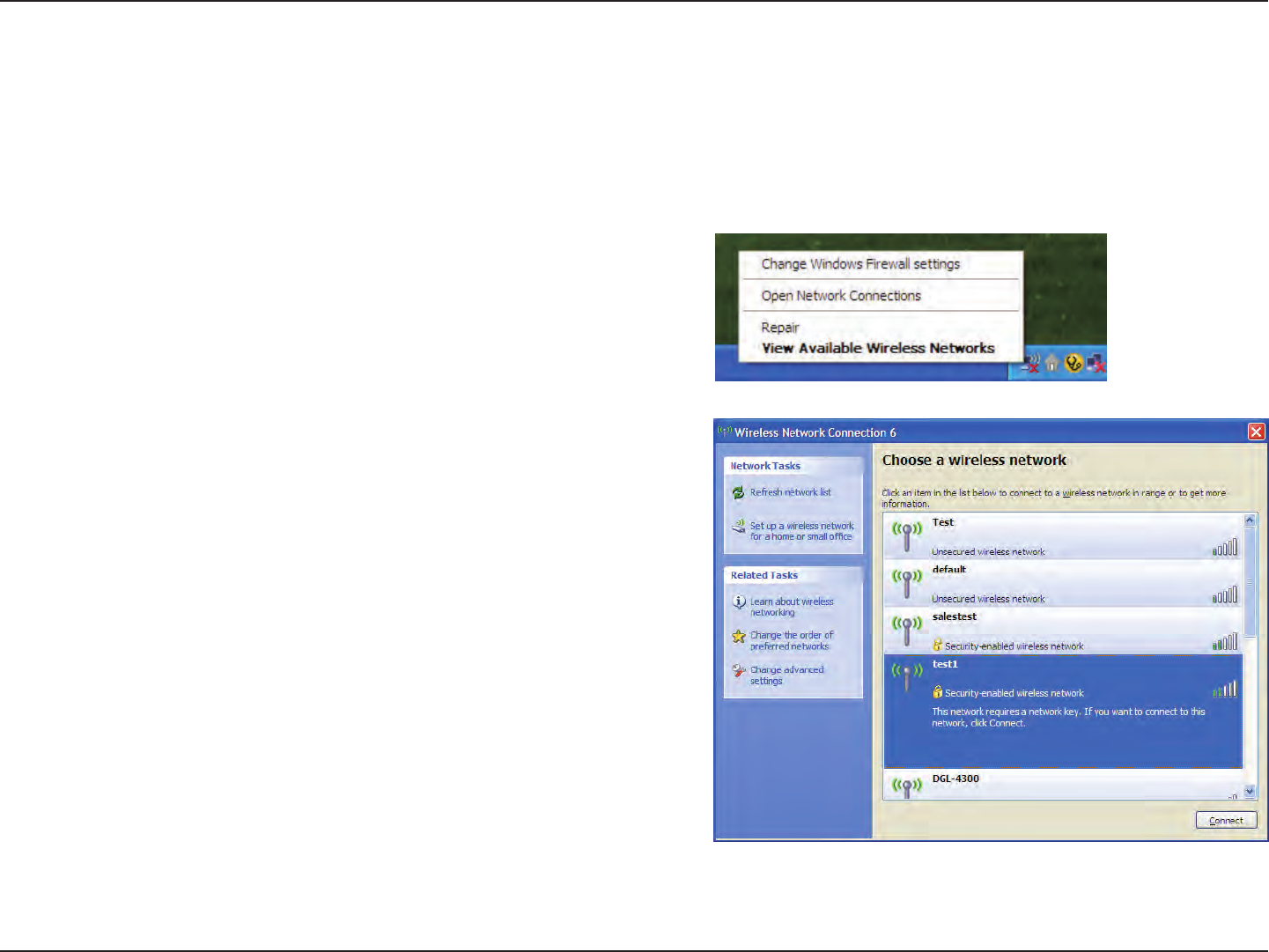
54D-Link DIR-619L User Manual
Section 5 - Connecting to a Wireless Network
Congure WEP
It is recommended to enable WEP on your wireless router or access point before conguring your wireless adapter. If you are
joining an existing network, you will need to know the WEP key being used.
2. Highlight the wireless network (SSID) you would like to
connect to and click Connect.
1. Open the Windows® XP Wireless Utility by right-clicking
on the wireless computer icon in your system tray
(lower-right corner of screen). Select View Available Wireless
Networks.
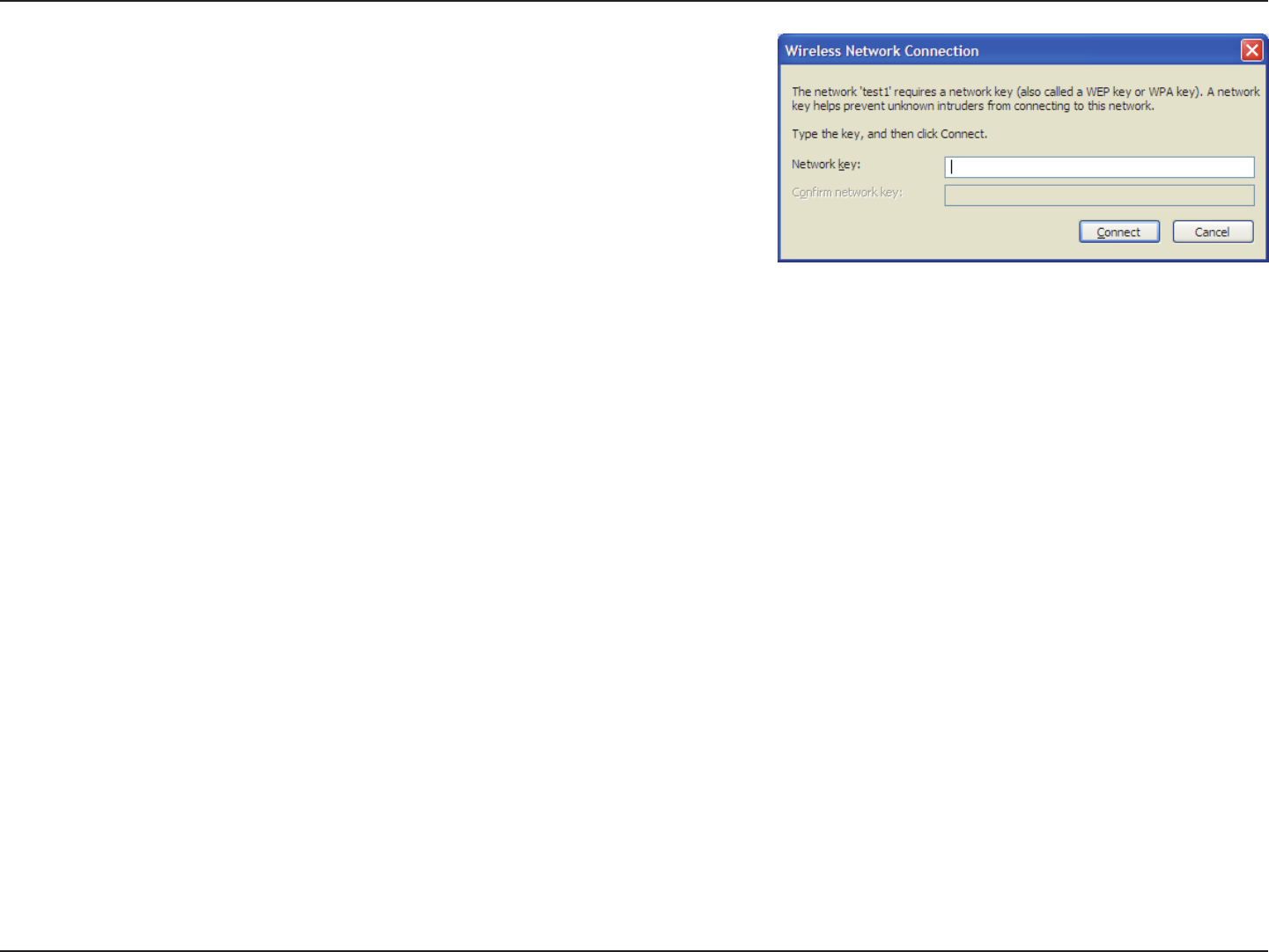
55D-Link DIR-619L User Manual
Section 5 - Connecting to a Wireless Network
3. The Wireless Network Connection box will appear. Enter the same WEP
key that is on your router and click Connect.
It may take 20-30 seconds to connect to the wireless network. If the
connection fails, please verify that the WEP settings are correct. The WEP
key must be exactly the same as on the wireless router.
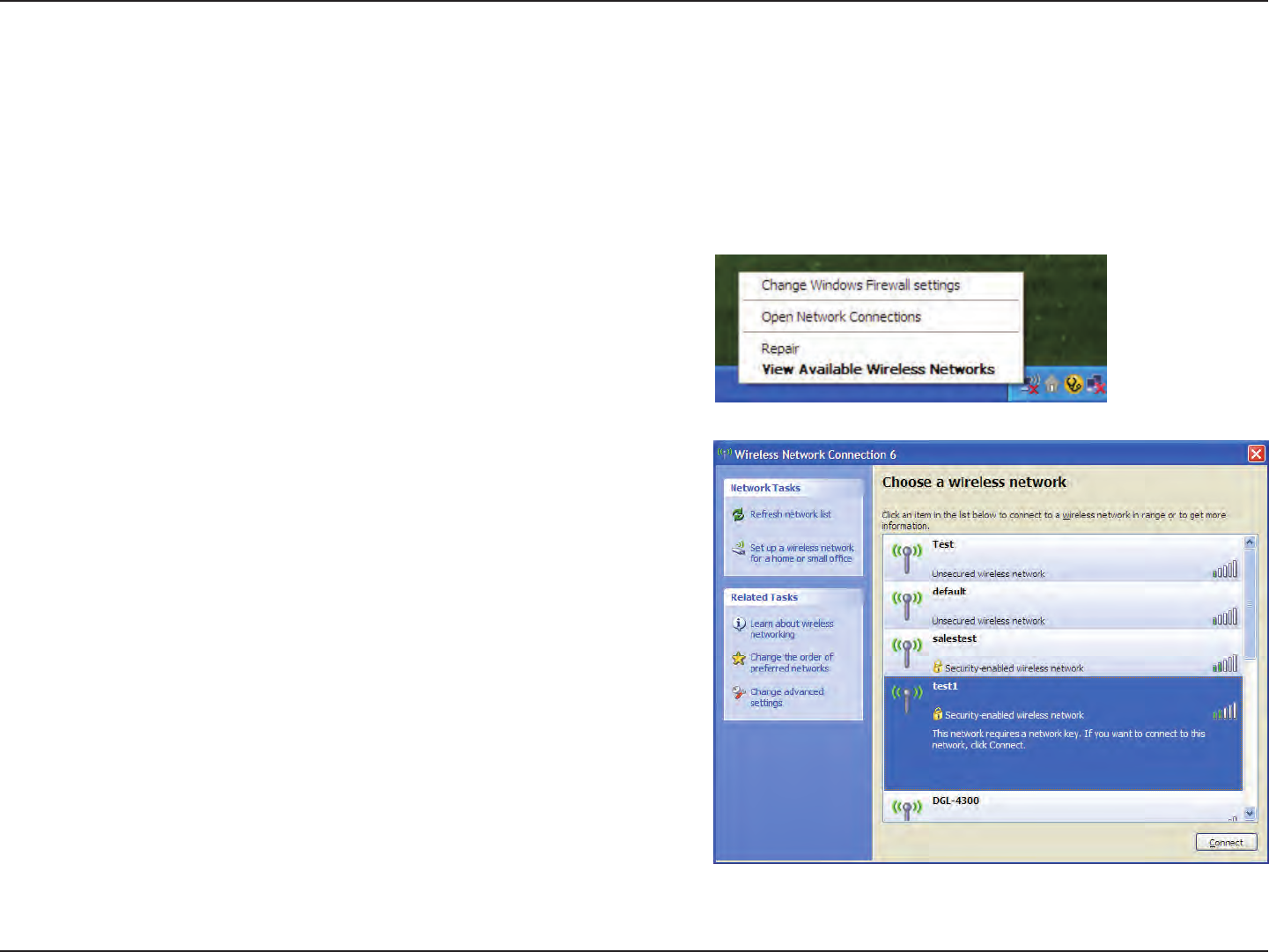
56D-Link DIR-619L User Manual
Section 5 - Connecting to a Wireless Network
Congure WPA-PSK
It is recommended to enable WEP on your wireless router or access point before conguring your wireless adapter. If you are
joining an existing network, you will need to know the WEP key being used.
2. Highlight the wireless network (SSID) you would like to
connect to and click Connect.
1. Open the Windows® XP Wireless Utility by right-clicking
on the wireless computer icon in your system tray
(lower-right corner of screen). Select View Available Wireless
Networks.
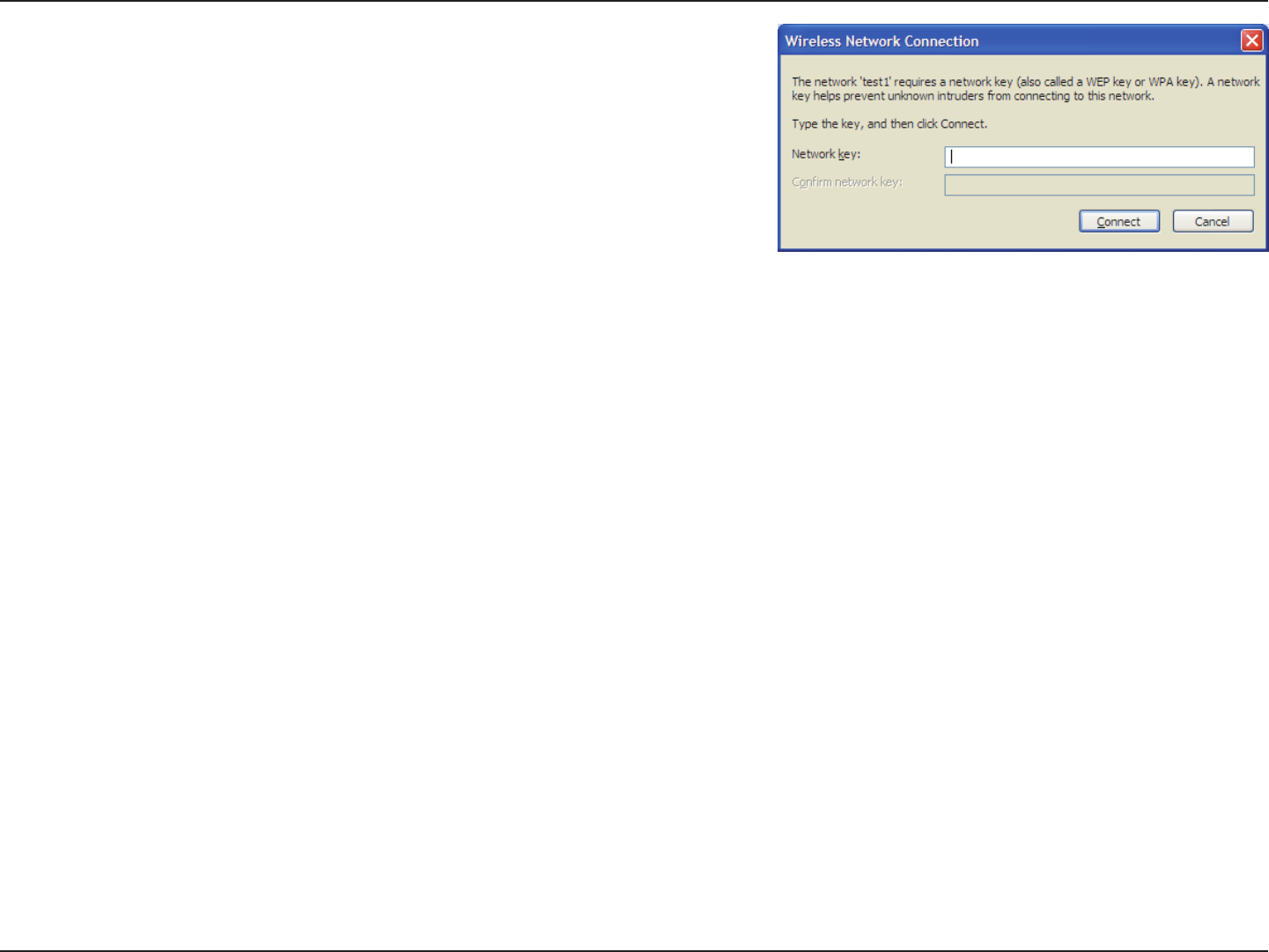
57D-Link DIR-619L User Manual
Section 5 - Connecting to a Wireless Network
3. The Wireless Network Connection box will appear. Enter the WPA-PSK
passphrase and click Connect.
It may take 20-30 seconds to connect to the wireless network. If the
connection fails, please verify that the WPA-PSK settings are correct. The
WPA-PSK passphrase must be exactly the same as on the wireless router.
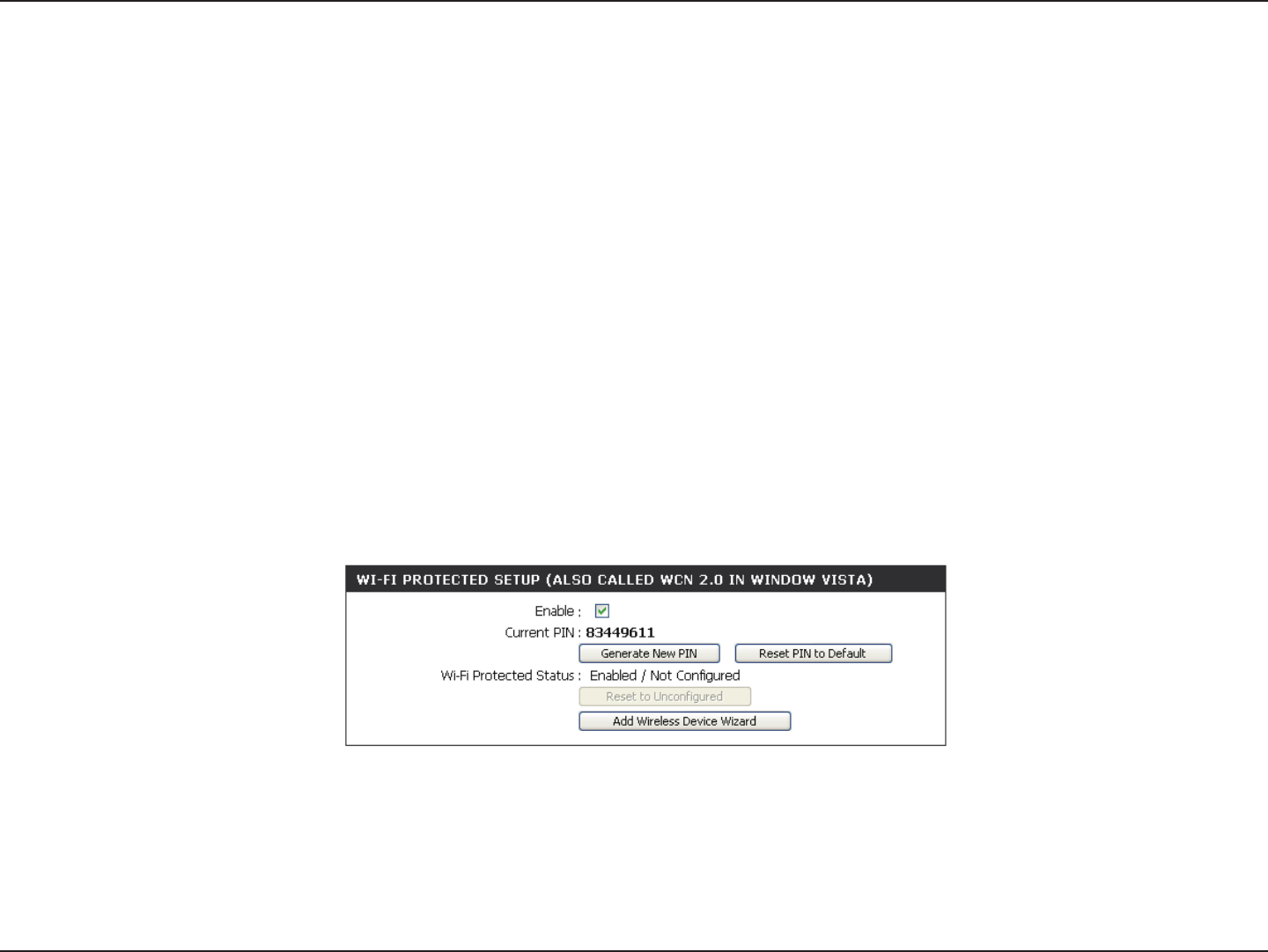
58D-Link DIR-619L User Manual
Section 6 - Setting Up Wi-Fi Protection (WCN 2.0 in Windows Vista)
Setting Up Wi-Fi Protection
(WCN 2.0 in Windows Vista)
The DIR-619L supports Wi-Fi protection, referred to as WCN 2.0 in Windows Vista. The instructions for setting this up depend
on whether you are using Windows Vista to congure the Router or third party software.
Initial Router Conguration for Wi-Fi Protection
When you rst set up the Router, Wi-Fi protection is disabled and uncongured. To enjoy the benets of Wi-Fi protection, the
Router must be both enabled and congured. There are three basic methods to accomplish this: use Windows Vista’s built-in
support for WCN 2.0, use software provided by a third party, or use the traditional Ethernet approach.
If you are running Windows Vista, tick the Enable checkbox on the Wireless Network window. Use the Current PIN that is
displayed on the Wireless Network window or choose to click the Generate New PIN button or Reset PIN to Default button.
If you are using third party software to set up Wi-Fi Protection, carefully follow the directions. When you are nished, proceed
to the next section to set up the newly-congured Router.

59D-Link DIR-619L User Manual
Section 6 - Setting Up Wi-Fi Protection (WCN 2.0 in Windows Vista)
Setting Up a Congured Router
Once the Router has been congured, you can use the push button on the Router or third party software to invite a newcomer
to join your Wi-Fi protected network. For maximum security, the software method is recommended. However, the push button
method is ideal if there is no access to a GUI.
If you are using the Router’s Wi-Fi Security push button option, simultaneously depress the push button located on the side of
the Router and the button on the client (or virtual button on the client’s GUI). Next click Finish. The Client’s software will then
allow a newcomer to join your secure, Wi-Fi protected network.
If you are using third party software, run the appropriate Wi-Fi Protected System utility. You will be asked to either use the push
button method or to manually enter the PIN. Follow the on-screen instructions.
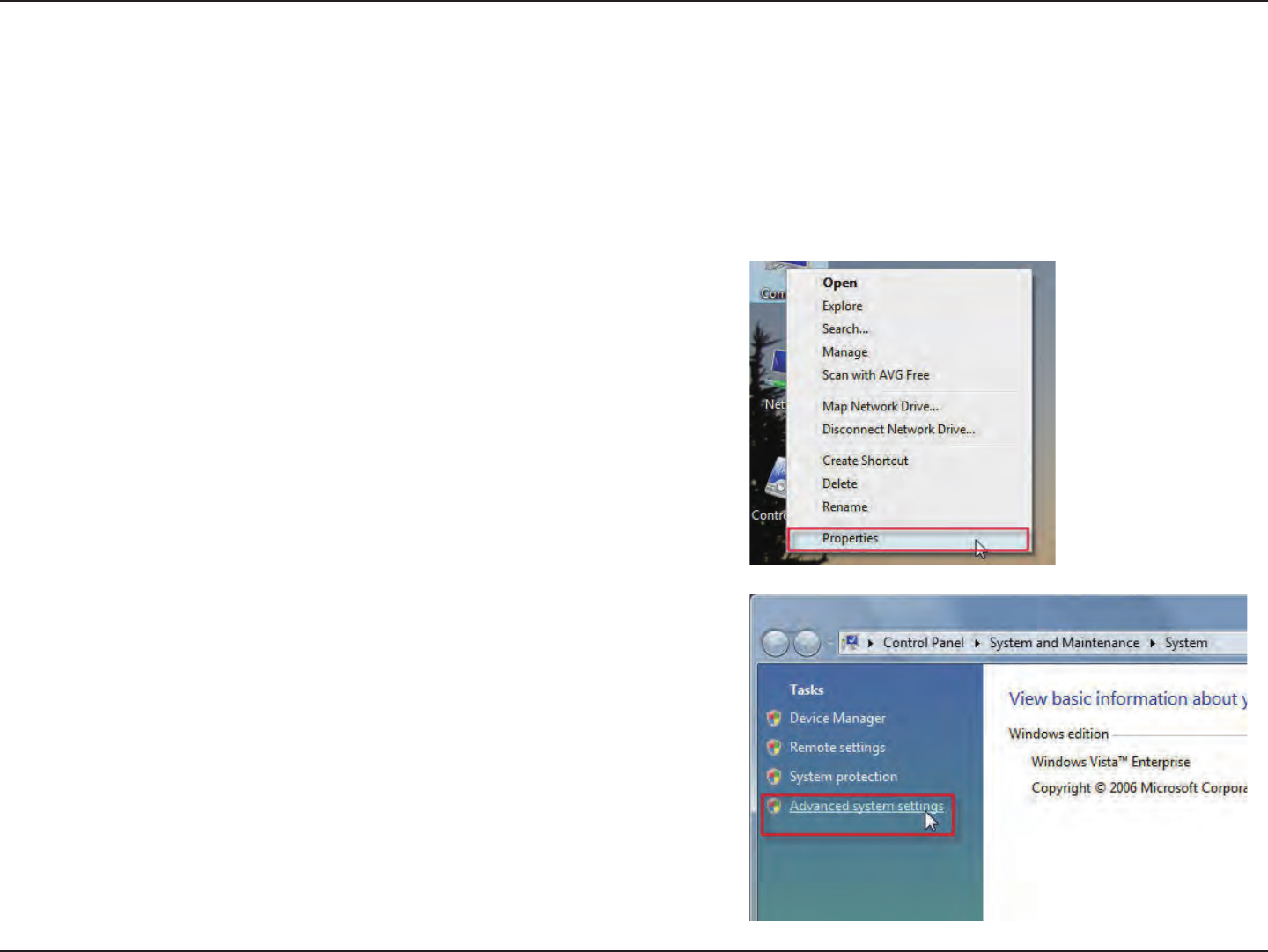
60D-Link DIR-619L User Manual
Section 7 - Changing the Computer Name and Joining a Workgroup
Changing the Computer Name and Joining a
Workgroup
The following are step-by-step directions to change the computer name and join a workgroup.
2. Click on the Advanced system settings link.
1. Click on Properties.
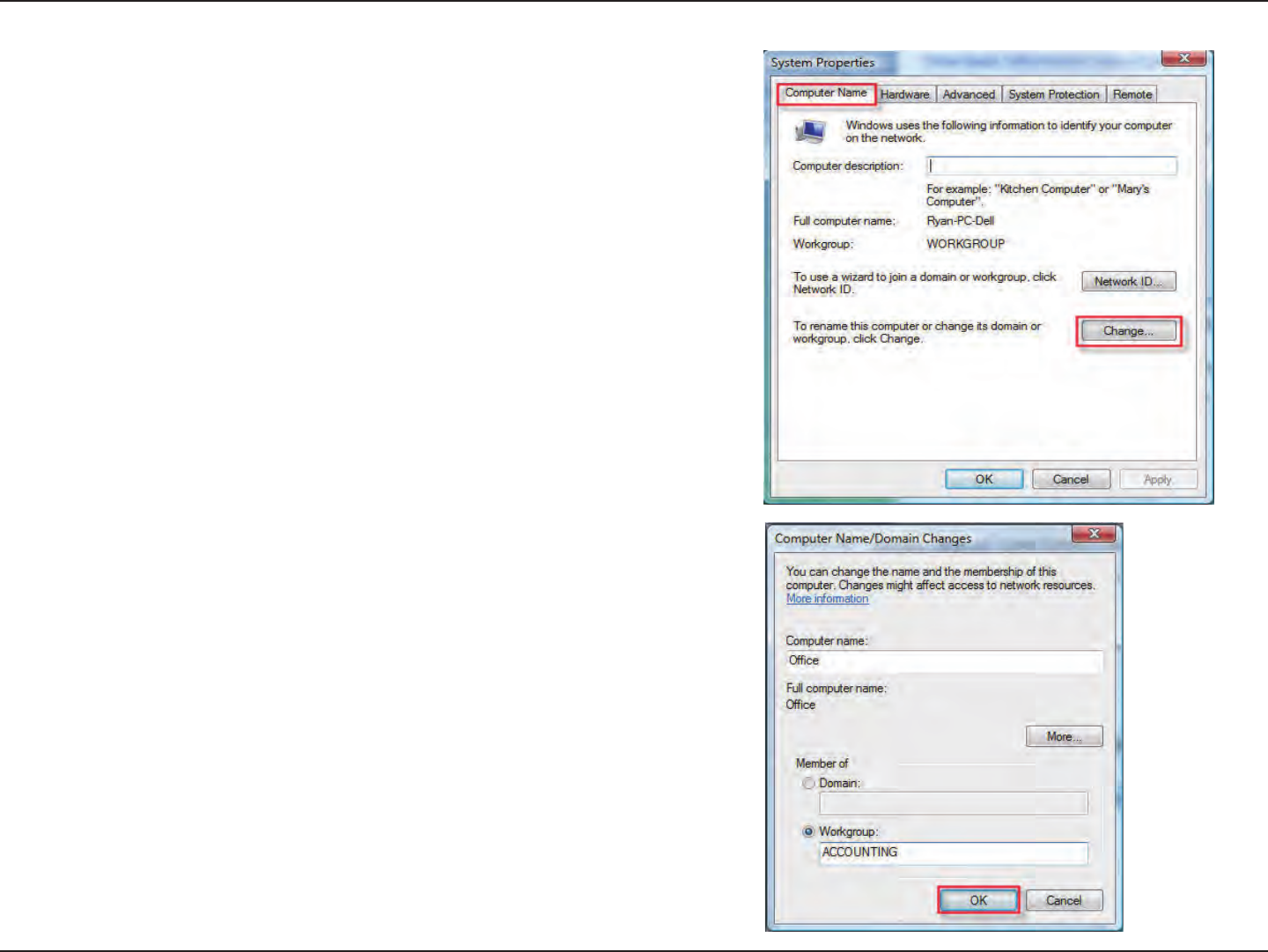
61D-Link DIR-619L User Manual
Section 7 - Changing the Computer Name and Joining a Workgroup
3. Click the Computer Name tab in the System Properties window and
enter a description of your computer in the textbox. When you are
nished, click the Change button.
4. Go to the Computer Name/Domain Changes window and
click the radio button next to the Workgroup you want to join.
When you are nished, click the OK button.
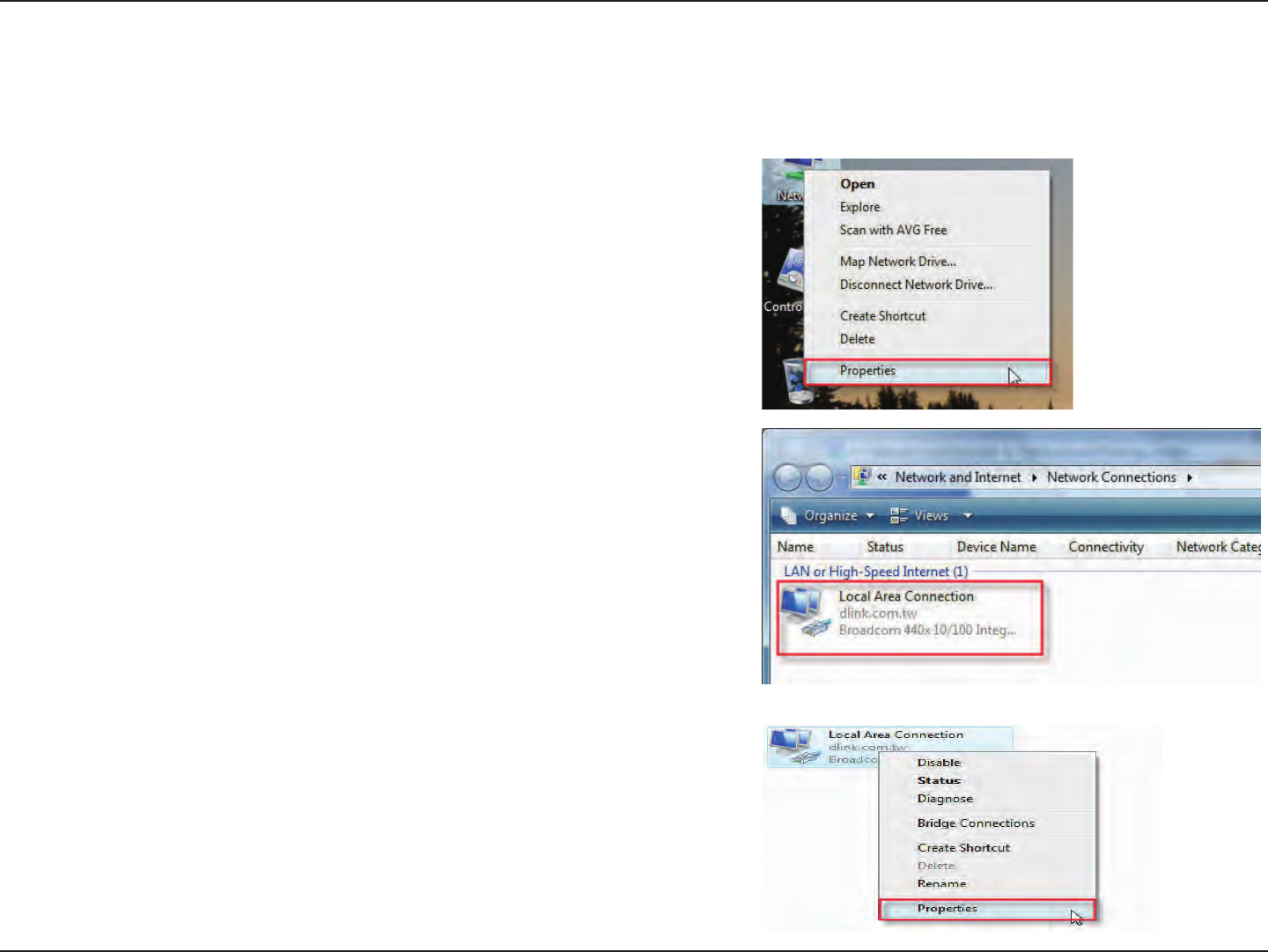
62D-Link DIR-619L User Manual
Section 8 - Conguring the IP Address in Vista
Conguring the IP Address in Vista
The following are step-by-step directions to congure the IP address in Windows Vista.
2. Go to the Network and Internet window and click the
appropriate Local Area Connection icon.
1. Click on Properties.
3. Right-click the Local Area Connection icon and then select
Properties from the drop-down menu.
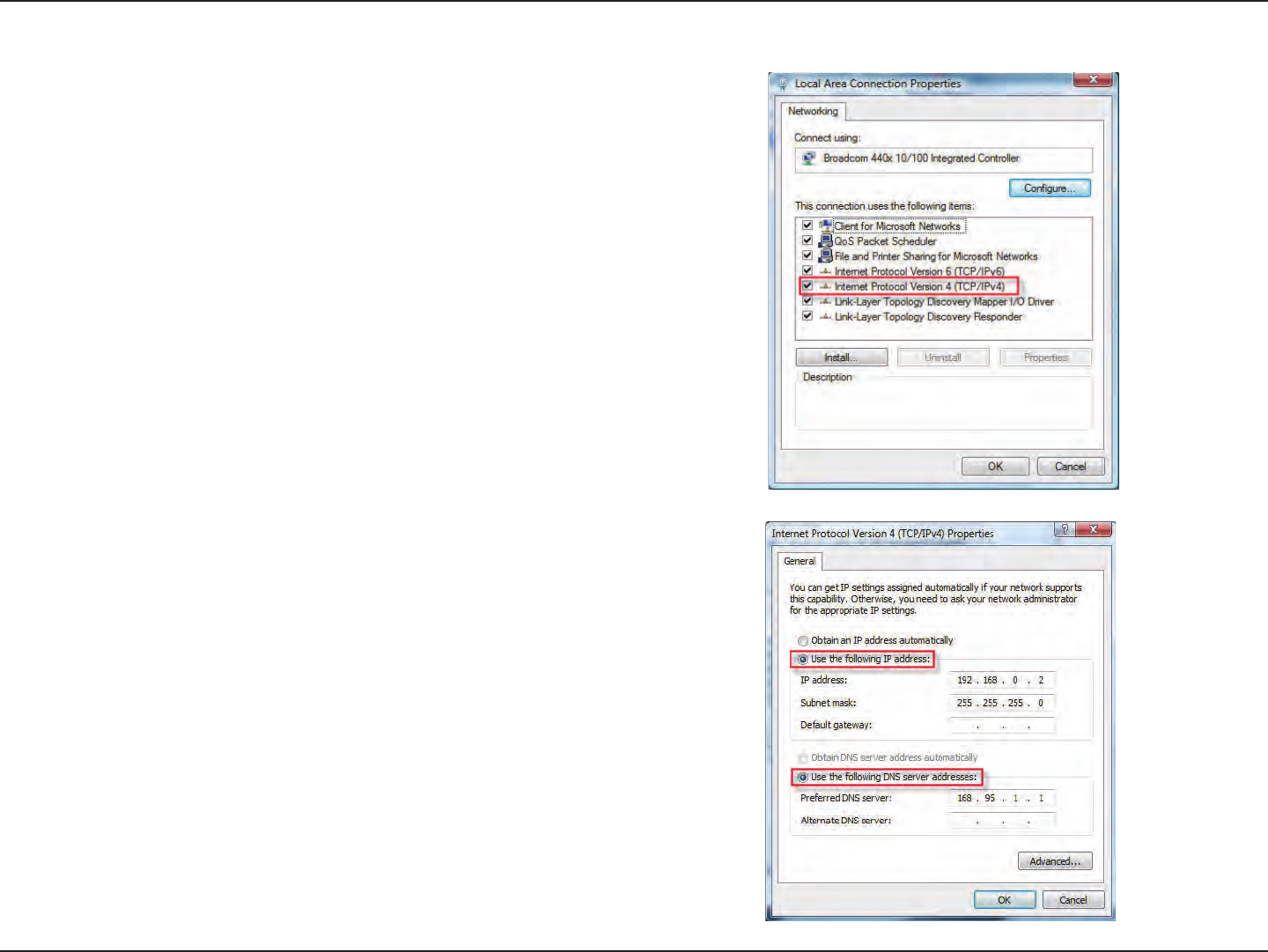
63D-Link DIR-619L User Manual
Section 8 - Conguring the IP Address in Vista
4. Tick the Internet Protocol Version 4 (TCP/IPv4) checkbox in the
Networking tab in the Local Area Connection Properties window.
5. Click the “Use the following IP address” option in the General
tab in the Local Area Connections Properties window and
enter the desired IP address in the space oered. Then click the
“Use the following DNS server addresses” option on the same
tab and enter the desired DNS server information.
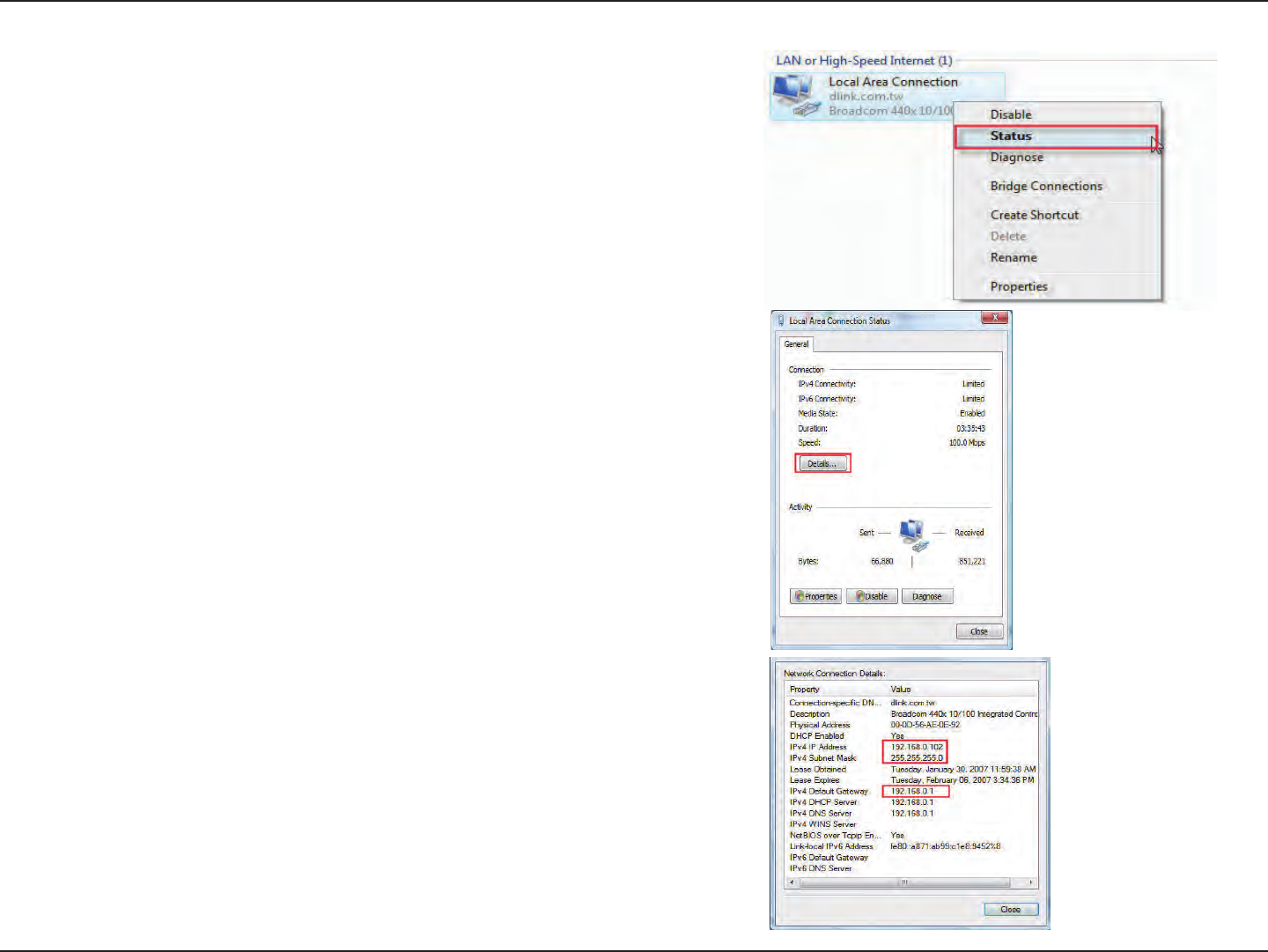
64D-Link DIR-619L User Manual
Section 8 - Conguring the IP Address in Vista
6. Right-click the Local Area Connection icon and then select Status from
the drop-down menu.
7. Go to the Local Area Connection Status window and click the
Details button.
8. Conrm your new settings on the Network Connection Status window.
When you are nished, click the Done button.
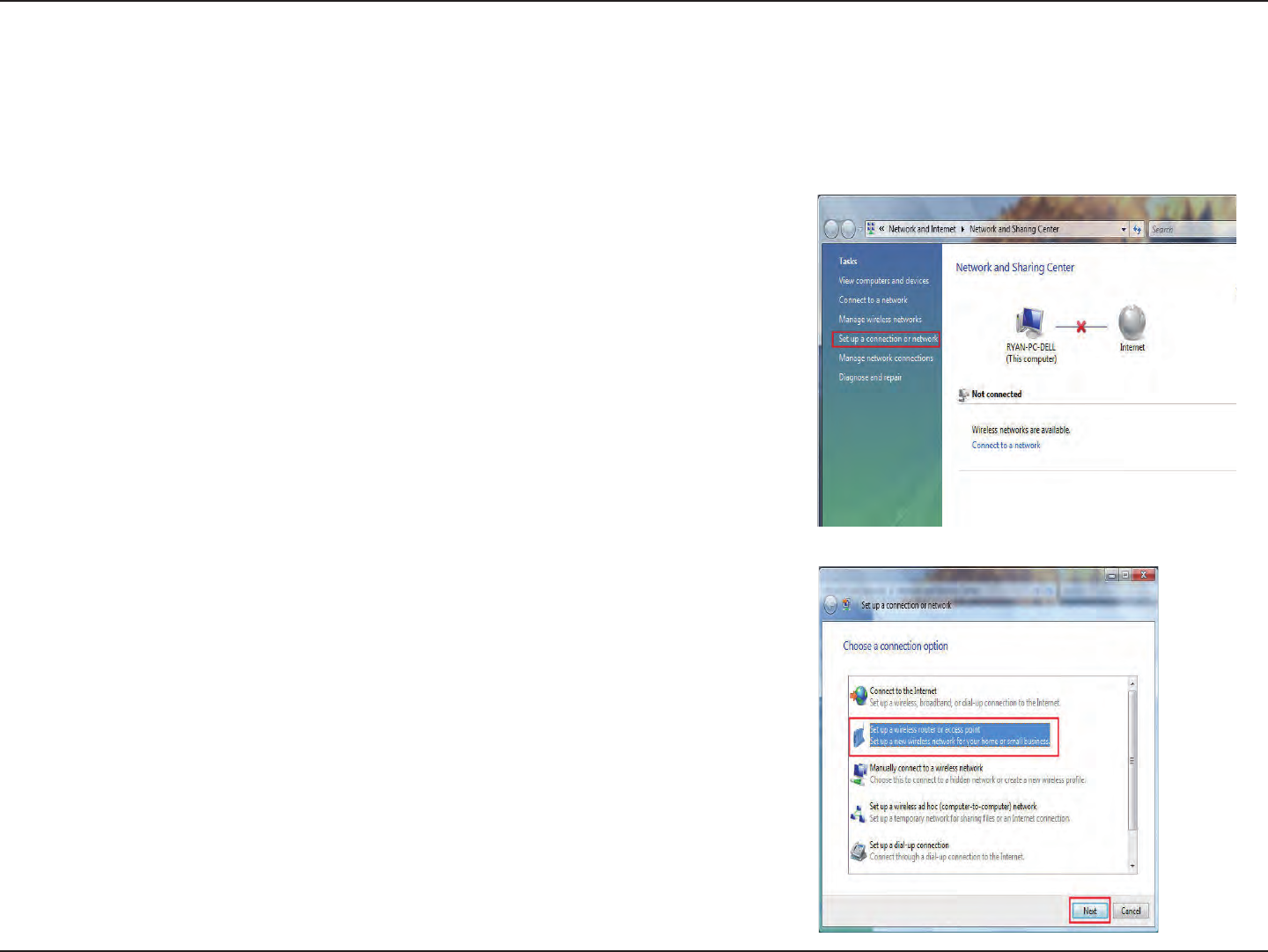
65D-Link DIR-619L User Manual
Section 9 - Setting Up a Connection Wirelessly
Setting Up a Connection or Network Wirelessly
The following are step-by-step directions to set up a wireless connection.
2. Go to the Set up a connection or network window and choose the Set up a
wireless router or access point Set up a new wireless network for your home
or business option. Click the Next button.
1. Click on Set up a connection or network in the Network and Sharing
Center section.
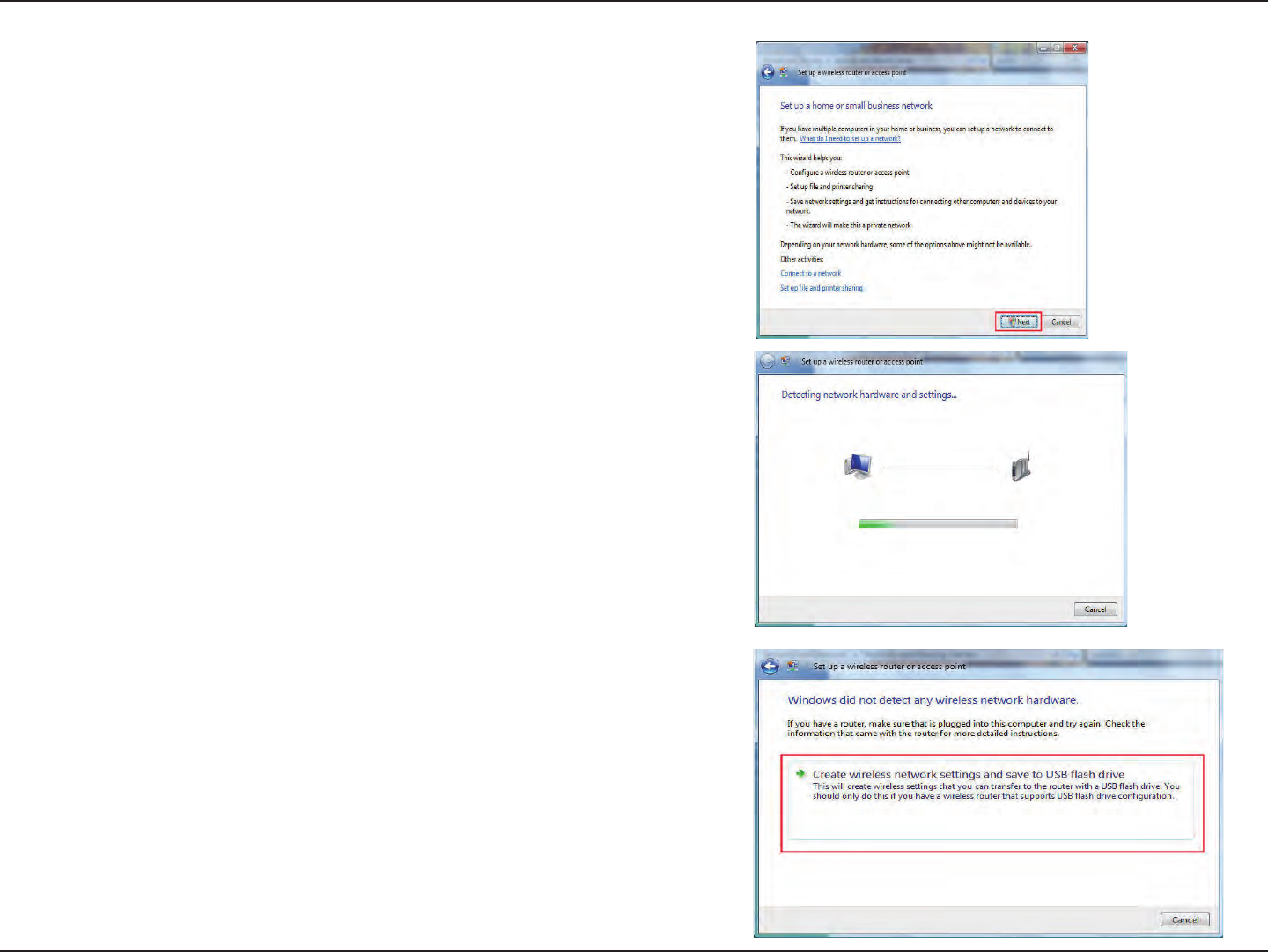
66D-Link DIR-619L User Manual
Section 9 - Setting Up a Connection Wirelessly
3. Click the Next button on the Set up a wireless router or access point
window.
4. The following window displays the system progress.
5. This window conrms that you want to create wireless network settings
that are savable to a USB ash drive.
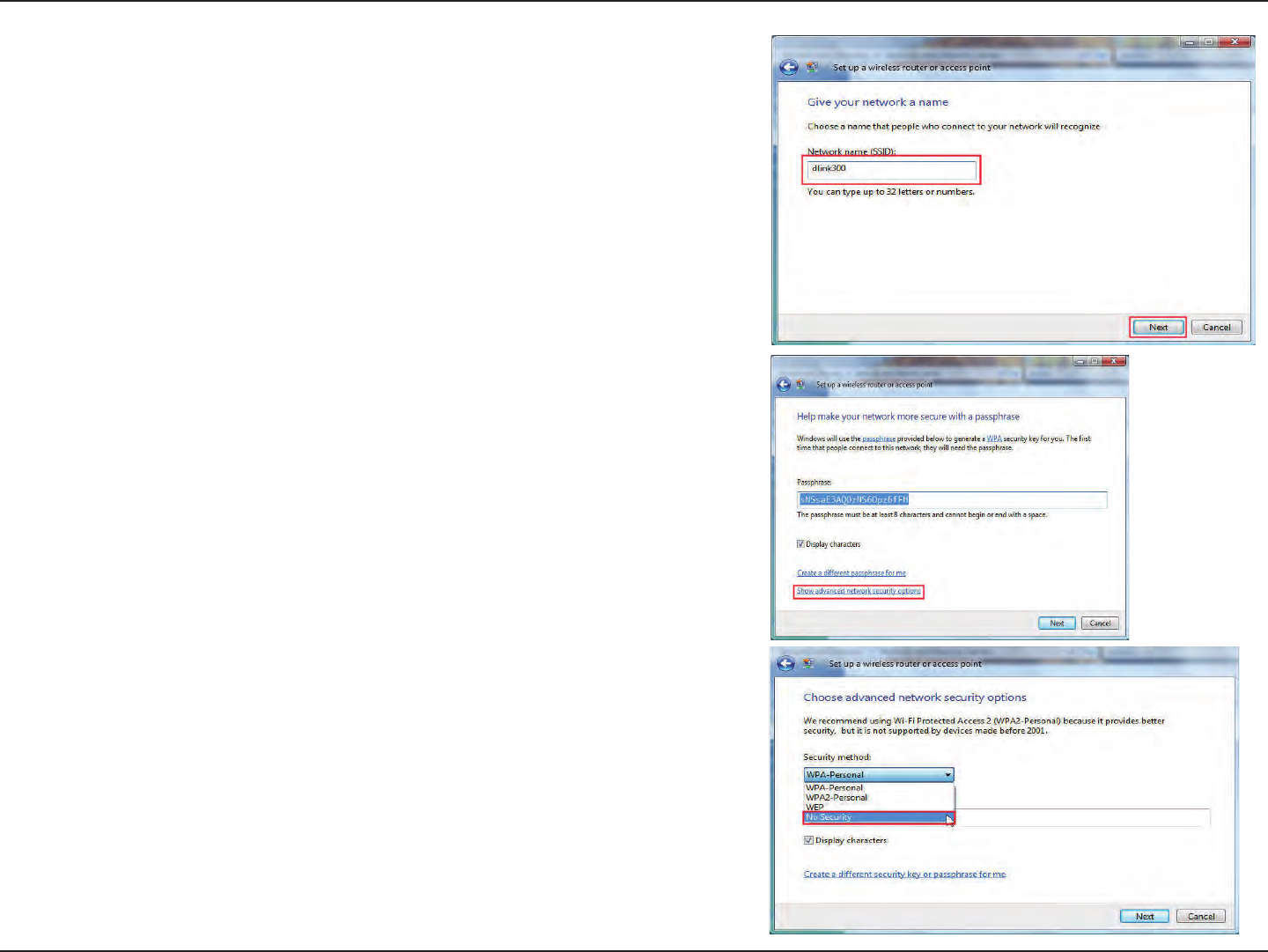
67D-Link DIR-619L User Manual
Section 9 - Setting Up a Connection Wirelessly
6. Enter a network name on the Give your network a name window in the
Set up a wireless router or access point wizard. Click the Next button.
7. Enter a passphrase on the Help make your network more secure with
a passphrase window in the Set up a wireless router or access point
wizard. Click the Show advanced network security options link.
8. Select security method on the Choose advanced network security
options window in the Set up a wireless router or access point wizard.
Click the Next button.
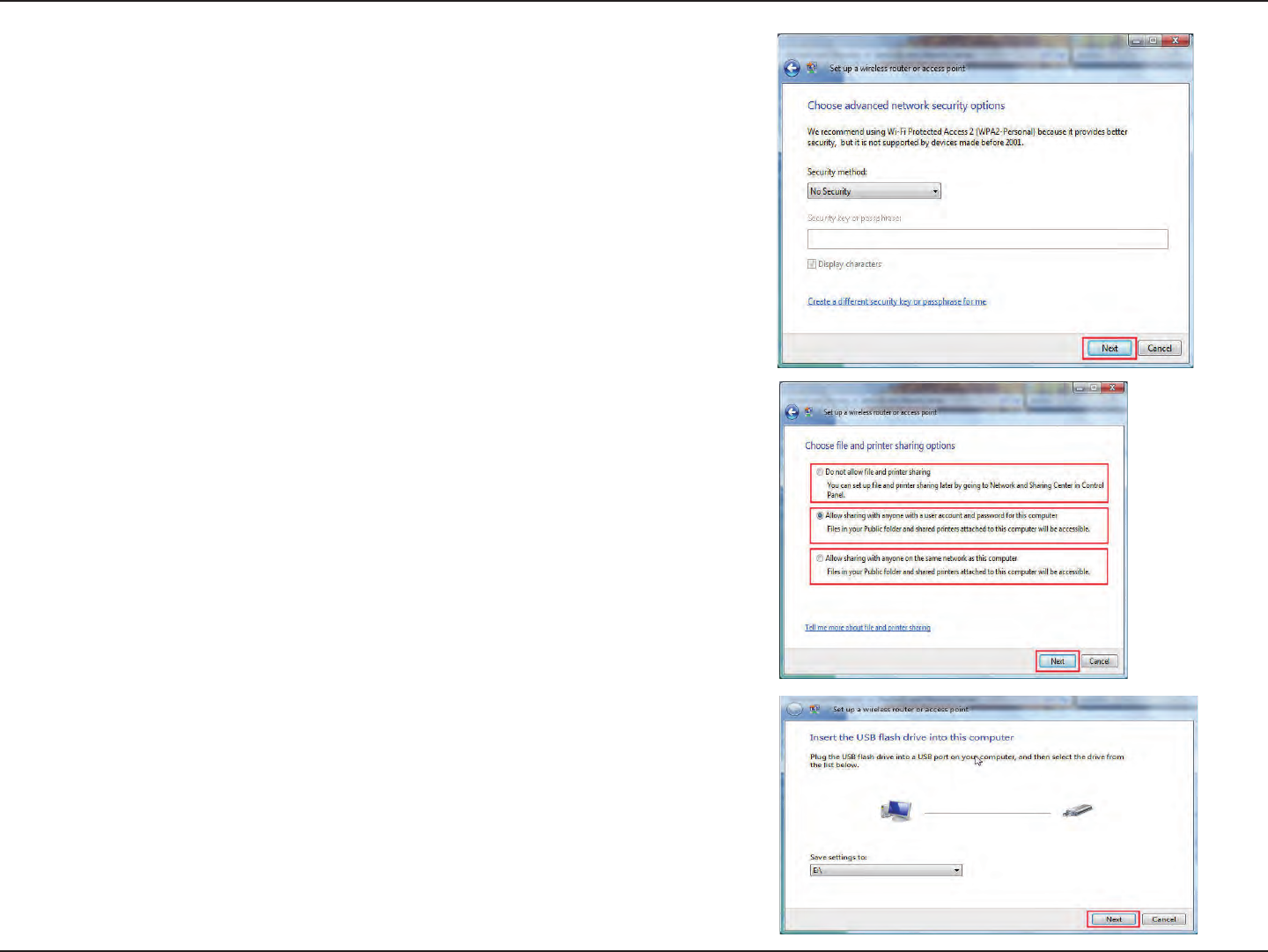
68D-Link DIR-619L User Manual
Section 9 - Setting Up a Connection Wirelessly
9. Once you have selected the desired security method on the Choose
advanced network security options window in the Set up a wireless
router or access point wizard, click the Next button.
10.Select the desired le and printer sharing option on the Choose le
and printer sharing options window in the Set up a wireless router or
access point wizard. Click the Next button.
11.Once you have saved your network settings to USB, use the pull-down
menu on the Insert the USB ash drive into this computer window in
the Set up a wireless router or access point wizard to select a destination
for your network settings. Click the Next button.
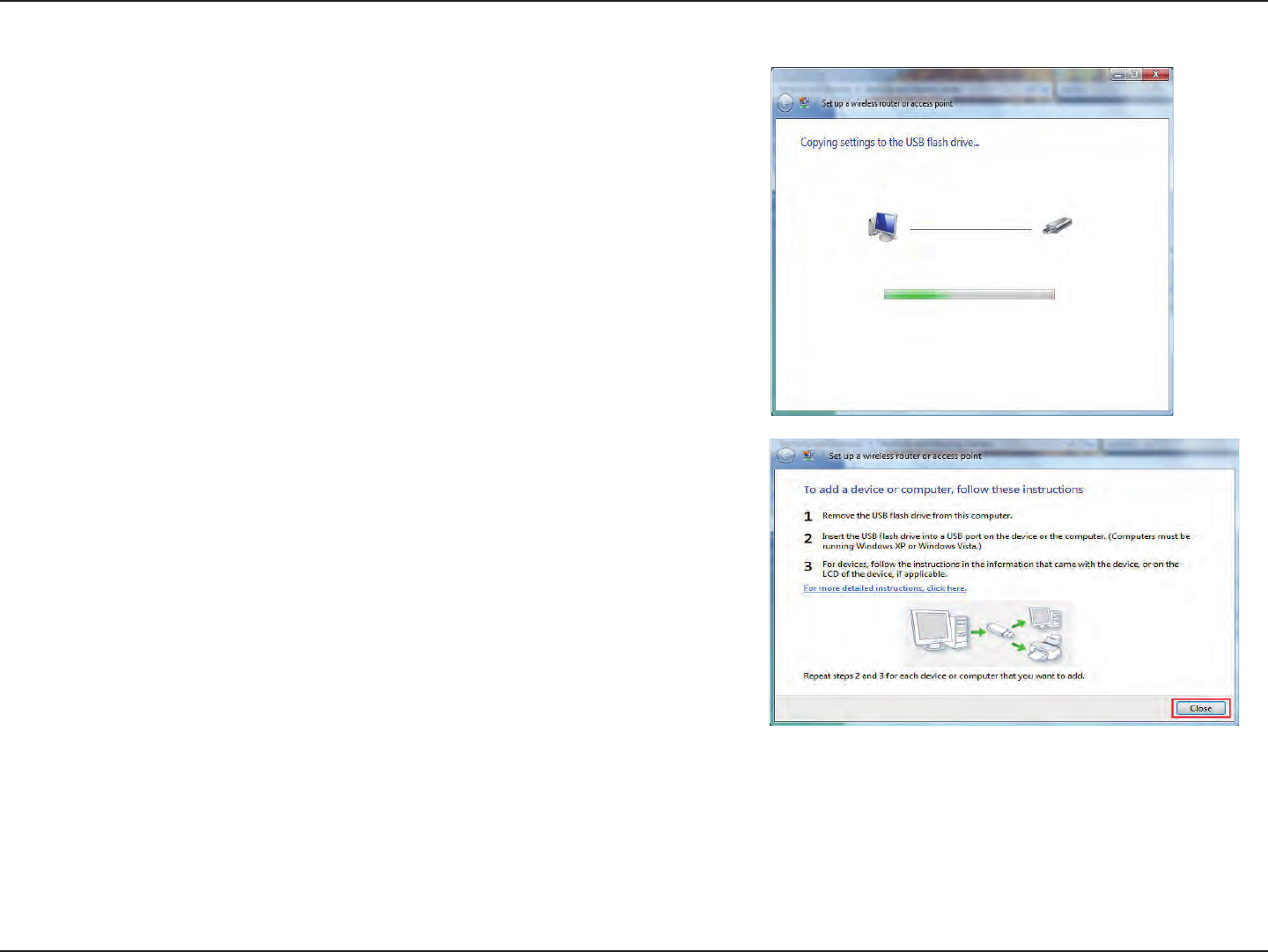
69D-Link DIR-619L User Manual
Section 9 - Setting Up a Connection Wirelessly
12.Once you have saved your network settings to USB, the
Copying settings to the USB drive window in the Set up a
wireless router or access point wizard opens to indicate the
system progress.
13.Once you are nished, the To add a device or computer, follow these
instructions window in the Set up a wireless router or access point
wizard opens. When you are nished, click the Close button.
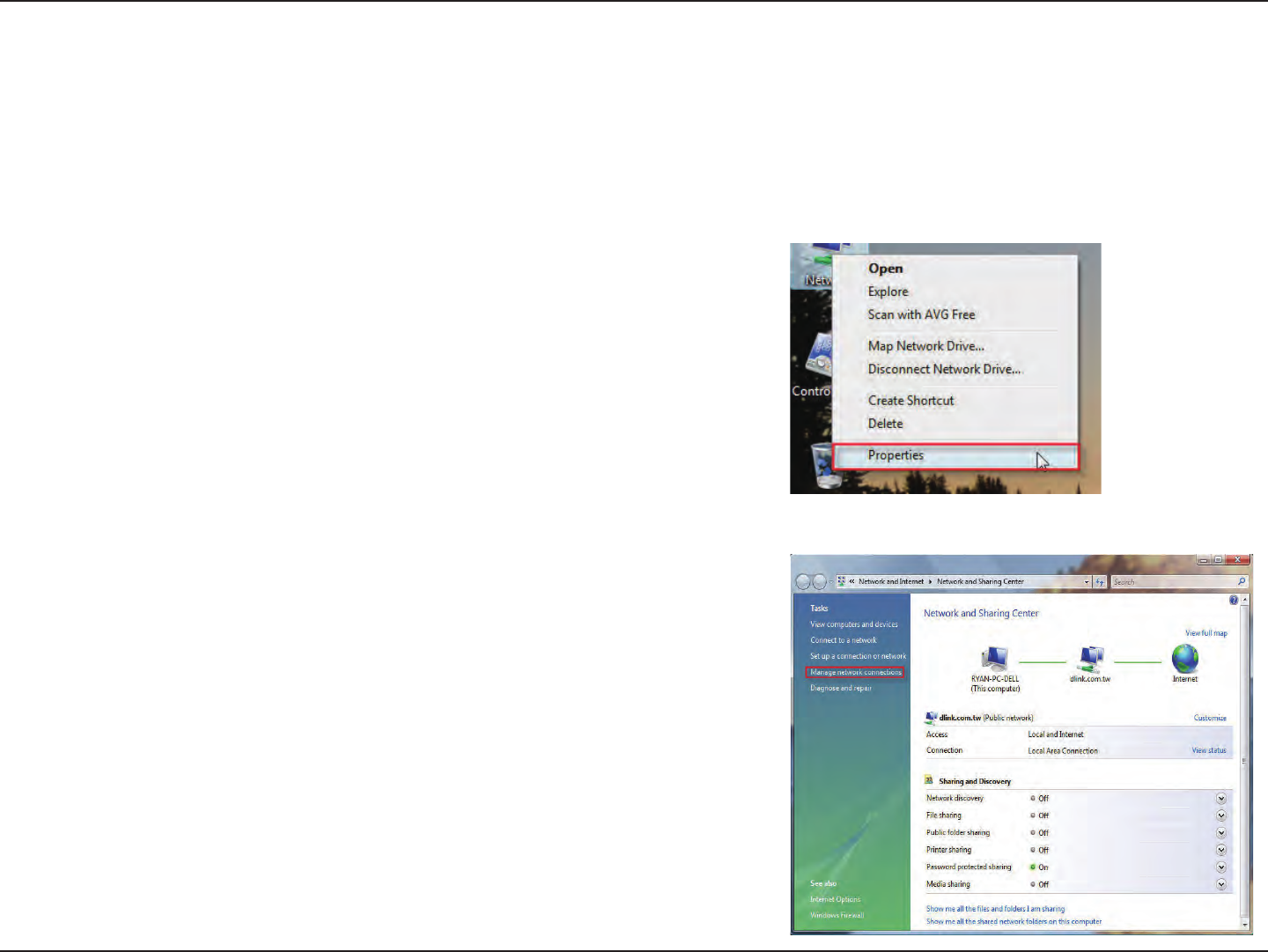
70D-Link DIR-619L User Manual
Section 10 - Connecting to a Secured Wireless Network (WEP, WPA-PSK & WPA2-PSK)
Connecting to a Secured Wireless Network (WEP,
WPA-PSK & WPA2-PSK)
The following are step-by-step directions to set up a wireless connection.
2. Click the Manage network connections link in the Network
and Sharing Center window.
1. Click on Properties.
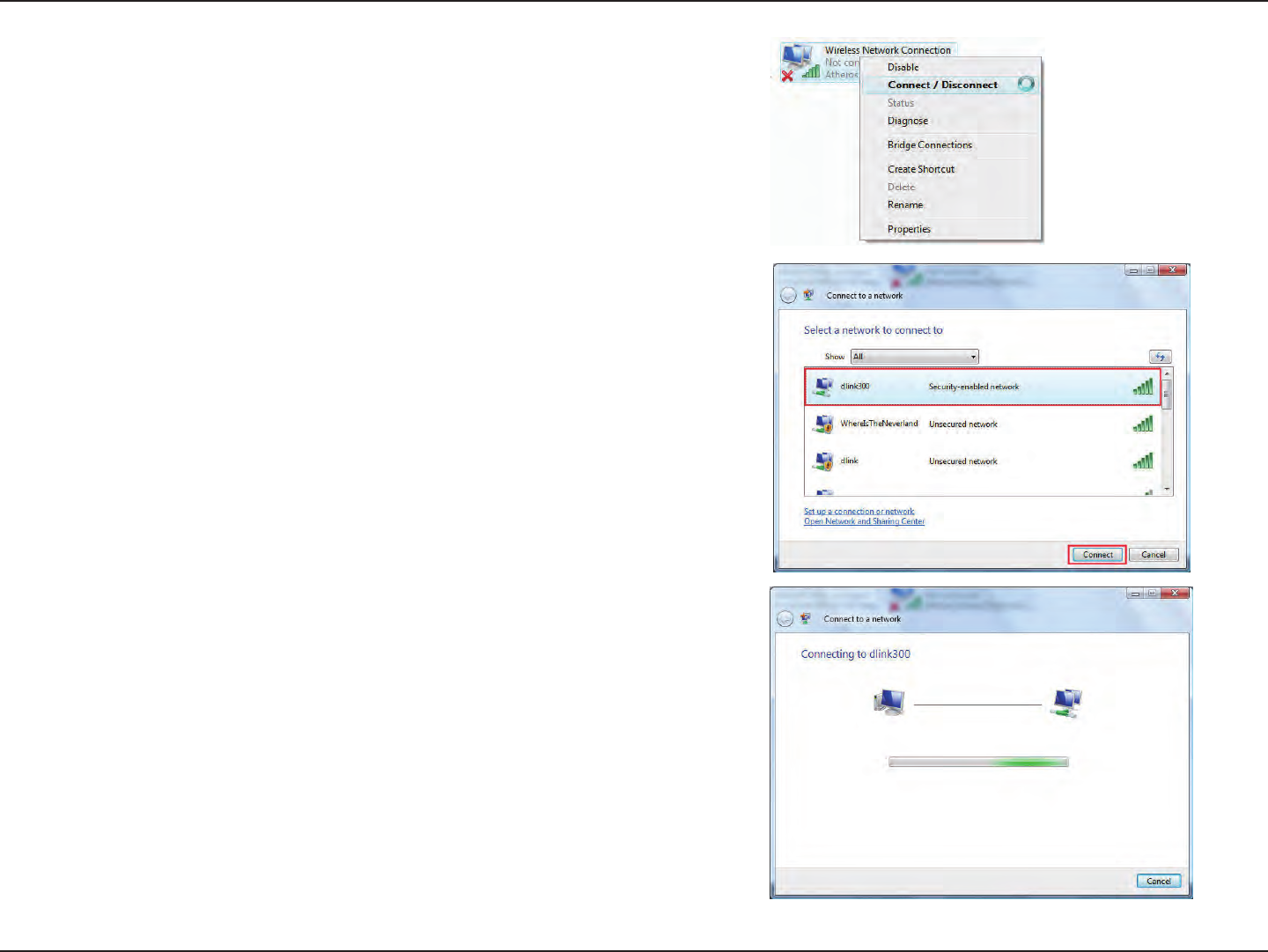
71D-Link DIR-619L User Manual
Section 10 - Connecting to a Secured Wireless Network (WEP, WPA-PSK & WPA2-PSK)
4. Select a network to connect to in the Select a network to connect to
window in the Connect to a network wizard and then click the Connect
button.
5. The following Connect to a network wizard window displays the system
progress.
3. Right-click the Wireless Network Connection entry and then select
Connect/Disconnect from the drop-down menu.
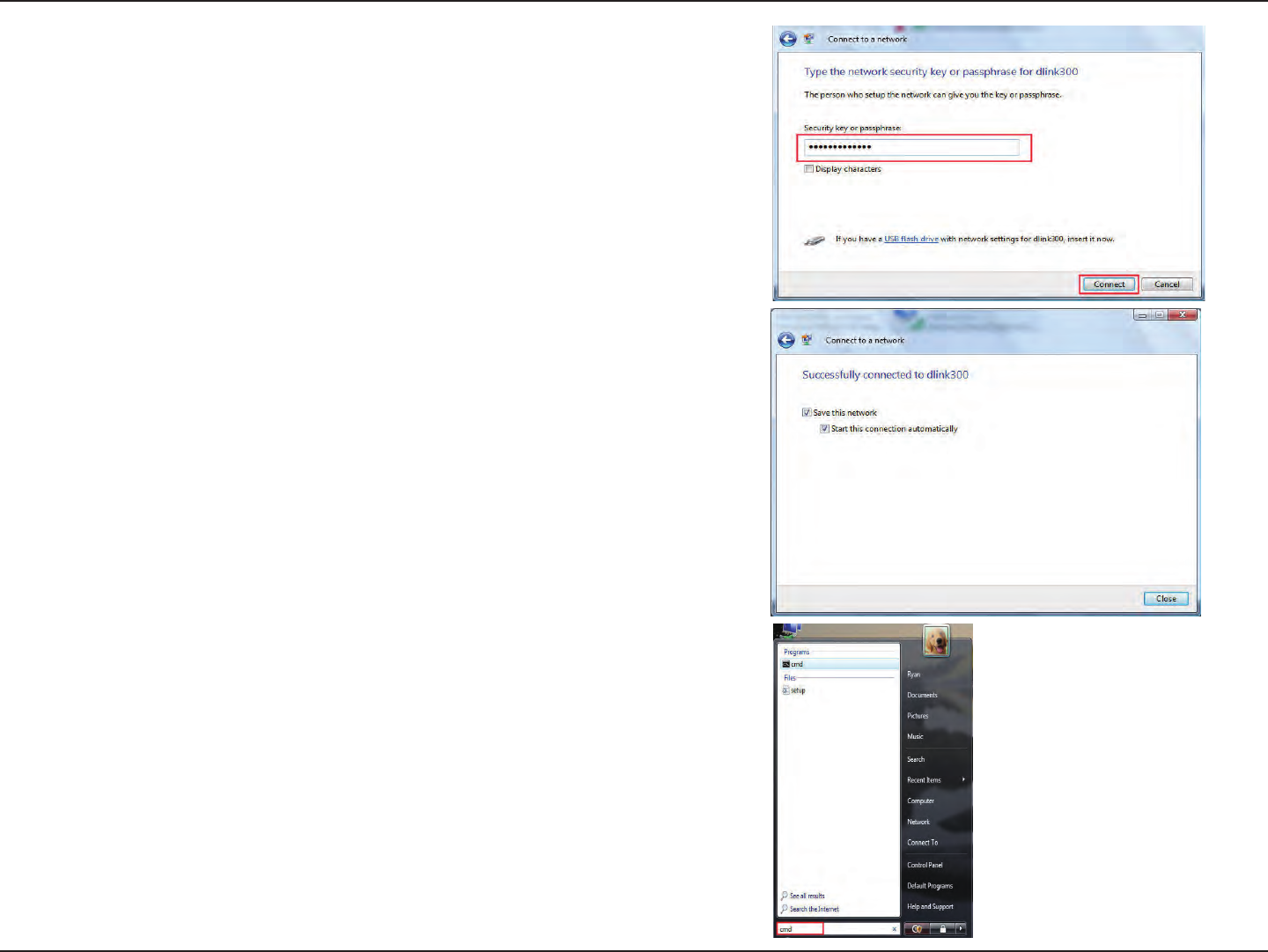
72D-Link DIR-619L User Manual
Section 10 - Connecting to a Secured Wireless Network (WEP, WPA-PSK & WPA2-PSK)
7. The following Successfully connected to dlink300 window in the
Connect to a network wizard is displayed. Choose to save to the network
and/or start the new connection automatically. When you are nished,
click the Close button.
8. The successful connection is displayed at the bottom of the
Windows start up menu.
6. Enter the network security key or passphrase for the Router in the
textbox provided in the Type the network security key or passphrase
for dlink300 window in the Connect a network wizard. When you are
nished, click the Connect button.
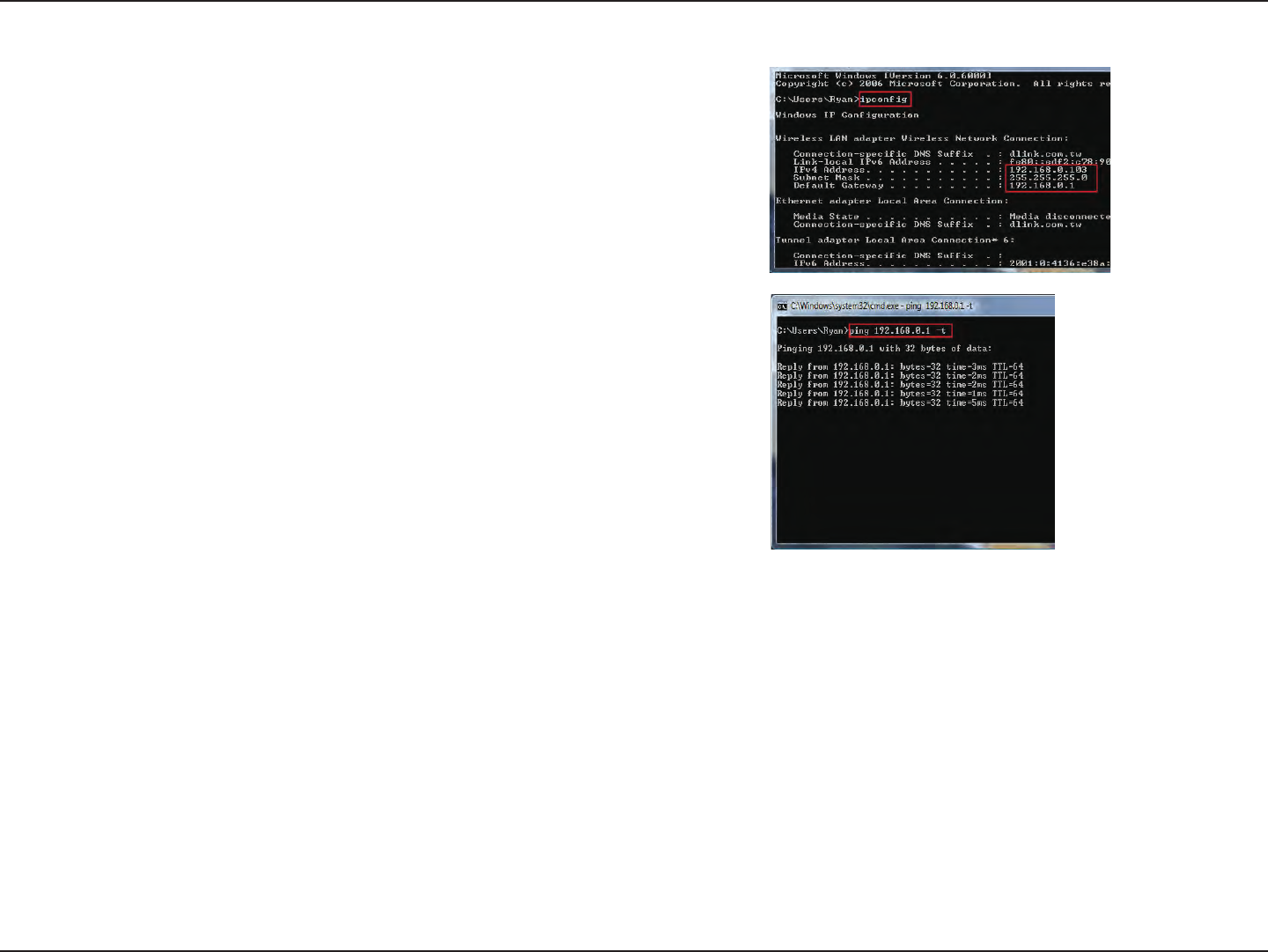
73D-Link DIR-619L User Manual
Section 10 - Connecting to a Secured Wireless Network (WEP, WPA-PSK & WPA2-PSK)
10.To test the new IP address, use the Ping feature of the command prompt.
9. Conrm your new settings by calling up the command prompt and then
entering the ipcong command.
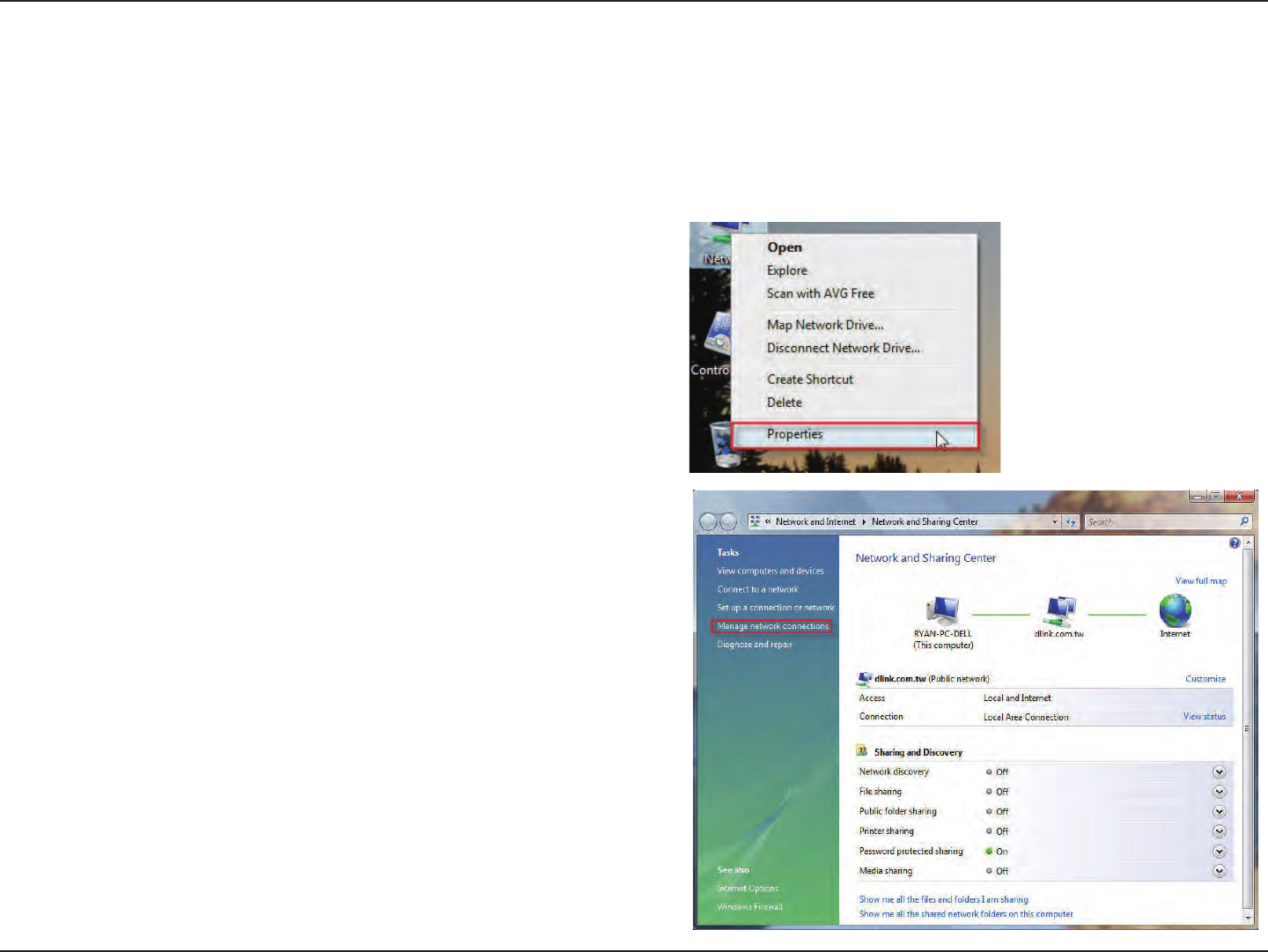
74D-Link DIR-619L User Manual
Section 11 - Connecting to an Unsecured Wireless Network
Connecting to an Unsecured Wireless Network
The following are step-by-step directions to set up an unsecured wireless connection.
2. Go to the Network and Sharing Center window and click the
Manage Network Connections link.
1. Click on Properties.
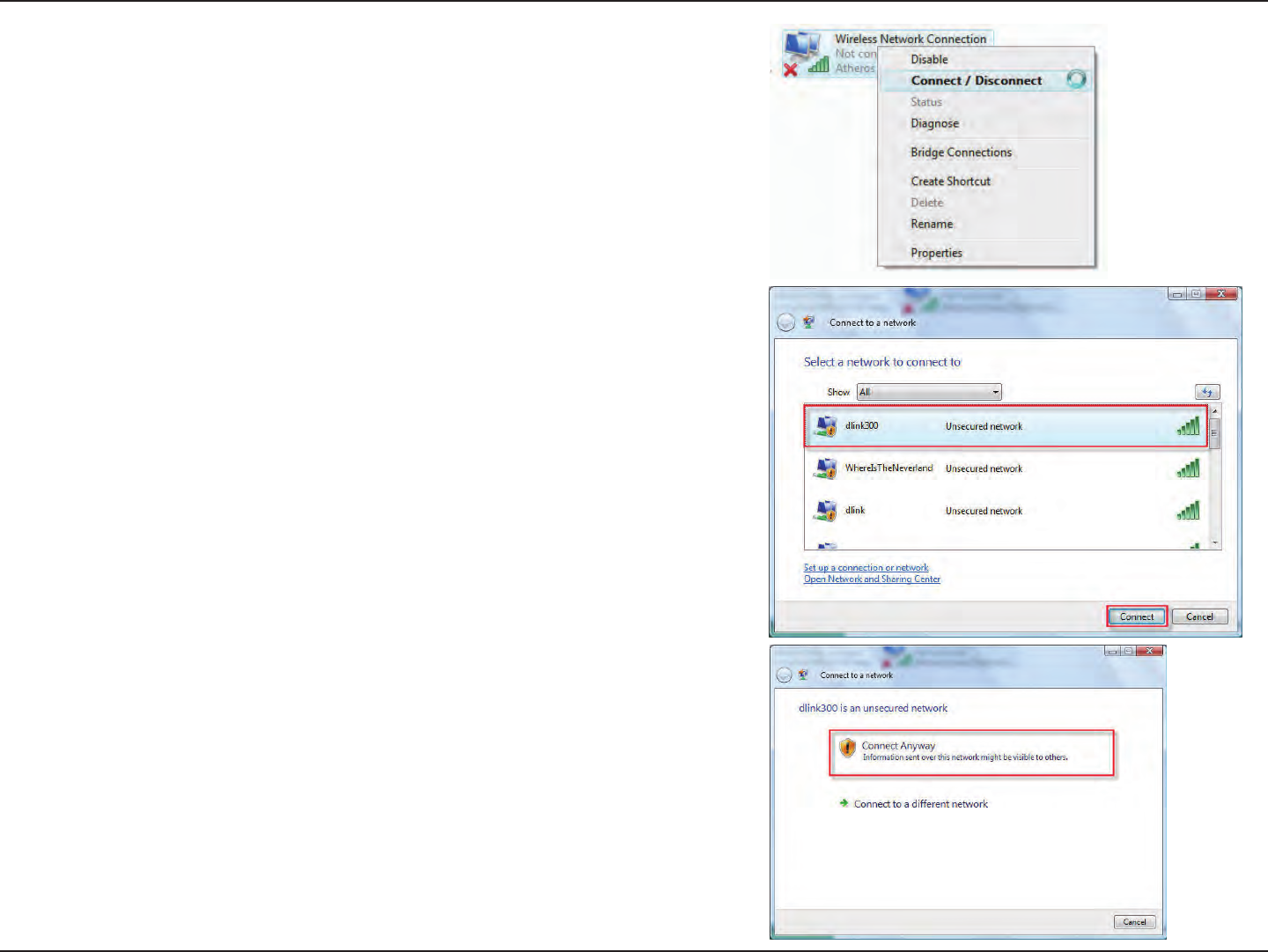
75D-Link DIR-619L User Manual
Section 11 - Connecting to an Unsecured Wireless Network
3. Right-click the Wireless Network Connection entry and then select
Connect/Disconnect from the drop-down menu.
4. Select a network to connect to in the Select a network to connect to
window in the Connect to a network wizard and then click the Connect
button.
5. Conrm your desire to connect anyway on the following Network
Connection Status window.
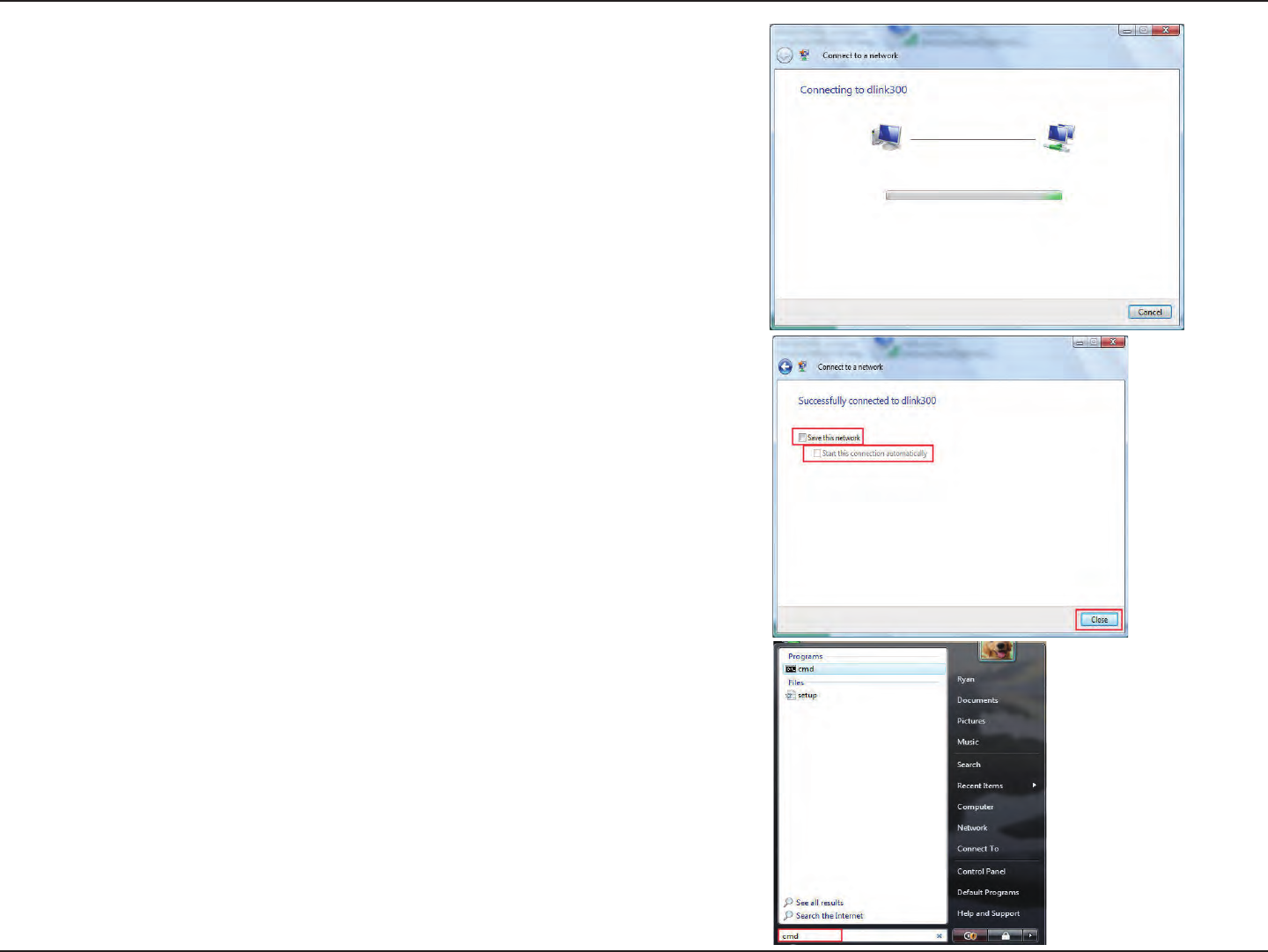
76D-Link DIR-619L User Manual
Section 11 - Connecting to an Unsecured Wireless Network
6. The following Connect to a network wizard window displays the system
progress.
7. The following Successfully connected to dlink300 window in the
Connect to a network wizard is displayed. Choose to save to the network
and/or start the new connection automatically. When you are nished,
click the Close button.
8. The successful connection is displayed at the bottom of the Windows
start up menu.
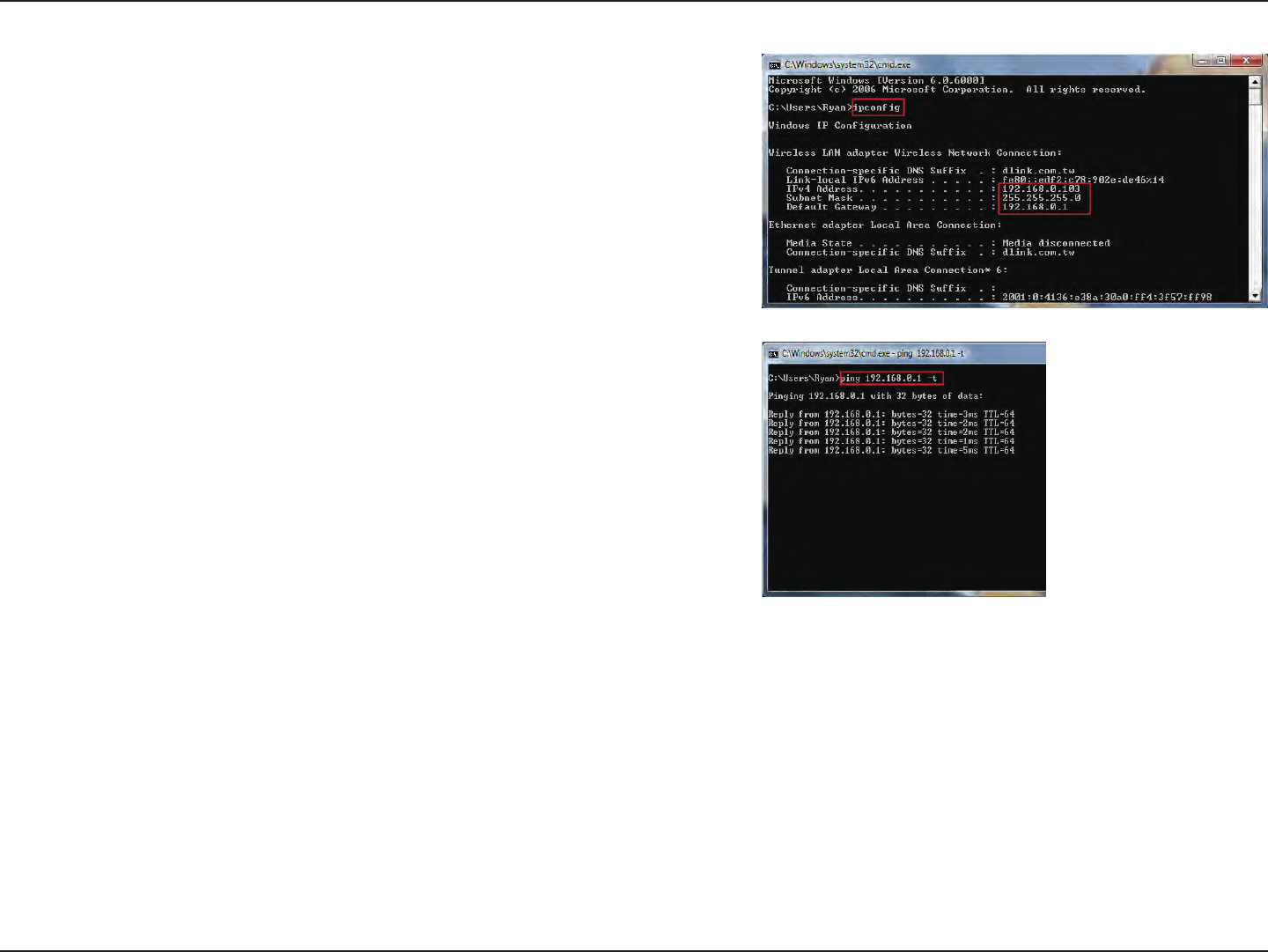
77D-Link DIR-619L User Manual
Section 11 - Connecting to an Unsecured Wireless Network
9. Conrm your new settings by calling up the command prompt and
then entering the ipcong command.
10.To test the new IP address, use the Ping feature of the command
prompt.

78D-Link DIR-619L User Manual
Section 12 - Troubleshooting
Troubleshooting
This chapter provides solutions to problems that can occur during the installation and operation of the DIR-619L. Read the
following descriptions if you are having problems. (The examples below are illustrated in Windows® XP. If you have a dierent
operating system, the screenshots on your computer will look similar to the following examples.)
1. Why can’t I access the web-based conguration utility?
When entering the IP address of the D-Link router (192.168.0.1 for example), you are not connecting to a website on the Internet
or have to be connected to the Internet. The device has the utility built-in to a ROM chip in the device itself. Your computer
must be on the same IP subnet to connect to the web-based utility.
• Make sure you have an updated Java-enabled web browser. We recommend the following:
• Internet Explorer 6.0 or higher
• Netscape 8 or higher
• Mozilla 1.7.12 (5.0) or higher
• Opera 8.5 or higher
• Safari 1.2 or higher (with Java 1.3.1 or higher)
• Camino 0.8.4 or higher
• Firefox 1.5 or higher
• Verify physical connectivity by checking for solid link lights on the device. If you do not get a solid link light, try using a dierent
cable or connect to a dierent port on the device if possible. If the computer is turned o, the link light may not be on.
• Disable any internet security software running on the computer. Software rewalls such as Zone Alarm, Black Ice, Sygate,
Norton Personal Firewall, and Windows® XP rewall may block access to the conguration pages. Check the help les included
with your rewall software for more information on disabling or conguring it.

79D-Link DIR-619L User Manual
Section 12 - Troubleshooting
• Congure your Internet settings:
• Go to Start > Settings > Control Panel. Double-click the Internet Options Icon. From the Security tab, click the
button to restore the settings to their defaults.
• Click the Connection tab and set the dial-up option to Never Dial a Connection. Click the LAN Settings button.
Make sure nothing is checked. Click OK.
• Go to the Advanced tab and click the button to restore these settings to their defaults. Click OK three times.
• Close your web browser (if open) and open it.
• Access the web management. Open your web browser and enter the IP address of your D-Link router in the address bar. This
should open the login page for your the web management.
• If you still cannot access the conguration, unplug the power to the router for 10 seconds and plug back in. Wait about 30
seconds and try accessing the conguration. If you have multiple computers, try connecting using a dierent computer.
2. What can I do if I forgot my password?
If you forgot your password, you must reset your router. Unfortunately this process will change all your settings back to the
factory defaults.
To reset the router, locate the reset button (hole) on the rear panel of the unit. With the router powered on, use a paperclip
to hold the button down for 10 seconds. Release the button and the router will go through its reboot process. Wait about
30 seconds to access the router. The default IP address is 192.168.0.1. When logging in, the username is admin and leave the
password box empty.
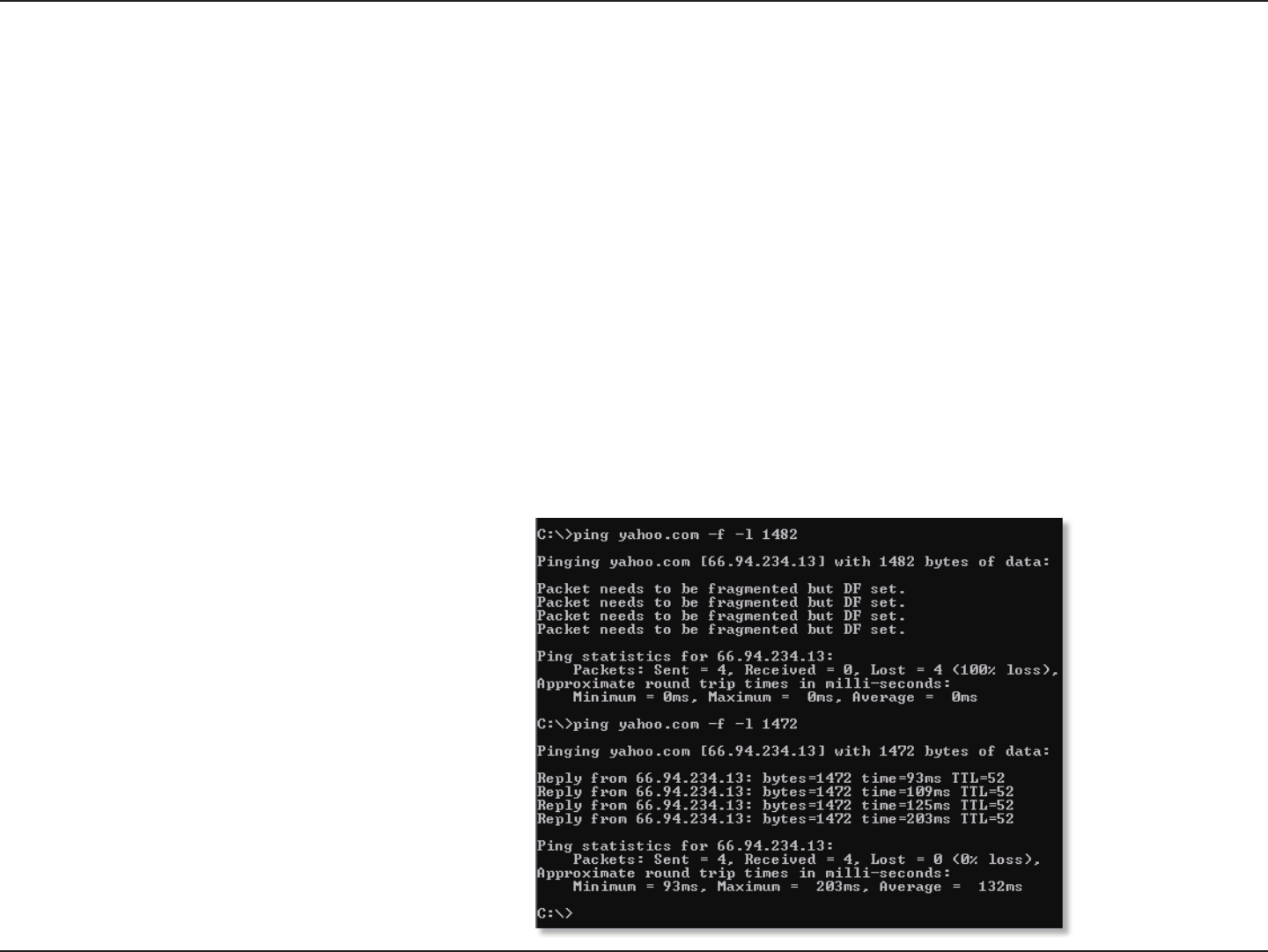
80D-Link DIR-619L User Manual
Section 12 - Troubleshooting
3. Why can’t I connect to certain sites or send and receive emails when connecting through my router?
If you are having a problem sending or receiving email, or connecting to secure sites such as eBay, banking sites, and Hotmail,
we suggest lowering the MTU in increments of ten (Ex. 1492, 1482, 1472, etc).
Note: AOL DSL+ users must use MTU of 1400.
To nd the proper MTU Size, you’ll have to do a special ping of the destination you’re trying to go to. A destination could be
another computer, or a URL.
• Click on Start and then click Run.
• Windows® 95, 98, and Me users type in command (Windows® NT, 2000, and XP users type in cmd) and press
Enter (or click OK).
• Once the window opens, you’ll need to do a special ping. Use the following syntax:
ping [url] [-f] [-l] [MTU value]
Example: ping yahoo.com -f -l 1472

81D-Link DIR-619L User Manual
Section 12 - Troubleshooting
You should start at 1472 and work your way down by 10 each time. Once you get a reply, go up by 2 until you get a fragmented
packet. Take that value and add 28 to the value to account for the various TCP/IP headers. For example, let’s say that 1452 was
the proper value, the actual MTU size would be 1480, which is the optimum for the network we’re working with (1452+28=1480).
Once you nd your MTU, you can now congure your router with the proper MTU size.
To change the MTU rate on your router follow the steps below:
• Open your browser, enter the IP address of your router (192.168.0.1) and click OK.
• Enter your username (admin) and password (blank by default). Click OK to enter the web conguration page
for the device.
• Click on Setup and then click Manual Congure.
• To change the MTU enter the number in the MTU eld and click the Save Settings button to save your settings.
• Test your email. If changing the MTU does not resolve the problem, continue changing the MTU in increments
of ten.

82D-Link DIR-619L User Manual
Appendix A - Wireless Basics
D-Link wireless products are based on industry standards to provide easy-to-use and compatible high-speed wireless
connectivity within your home, business or public access wireless networks. Strictly adhering to the IEEE standard, the D-Link
wireless family of products will allow you to securely access the data you want, when and where you want it. You will be able
to enjoy the freedom that wireless networking delivers.
A wireless local area network (WLAN) is a cellular computer network that transmits and receives data with radio signals instead of
wires. Wireless LANs are used increasingly in both home and oce environments, and public areas such as airports, coee shops
and universities. Innovative ways to utilize WLAN technology are helping people to work and communicate more eciently.
Increased mobility and the absence of cabling and other xed infrastructure have proven to be benecial for many users.
Wireless users can use the same applications they use on a wired network. Wireless adapter cards used on laptop and desktop
systems support the same protocols as Ethernet adapter cards.
Under many circumstances, it may be desirable for mobile network devices to link to a conventional Ethernet LAN in order to
use servers, printers or an Internet connection supplied through the wired LAN. A Wireless Router is a device used to provide
this link.
Wireless Basics

83D-Link DIR-619L User Manual
Appendix A - Wireless Basics
What is Wireless?
Wireless or Wi-Fi technology is another way of connecting your computer to the network without using wires. Wi-Fi uses radio
frequency to connect wirelessly, so you have the freedom to connect computers anywhere in your home or oce network.
Why D-Link Wireless?
D-Link is the worldwide leader and award winning designer, developer, and manufacturer of networking products. D-Link
delivers the performance you need at a price you can aord. D-Link has all the products you need to build your network.
How does wireless work?
Wireless works similar to how cordless phone work, through radio signals to transmit data from one point A to point B. But
wireless technology has restrictions as to how you can access the network. You must be within the wireless network range area
to be able to connect your computer. There are two dierent types of wireless networks Wireless Local Area Network (WLAN),
and Wireless Personal Area Network (WPAN).
Wireless Local Area Network (WLAN)
In a wireless local area network, a device called an Access Point (AP) connects computers to the network. The access point has
a small antenna attached to it, which allows it to transmit data back and forth over radio signals. With an indoor access point
as seen in the picture, the signal can travel up to 300 feet. With an outdoor access point the signal can reach out up to 30 miles
to serve places like manufacturing plants, industrial locations, college and high school campuses, airports, golf courses, and
many other outdoor venues.

84D-Link DIR-619L User Manual
Appendix A - Wireless Basics
Wireless Personal Area Network (WPAN)
Bluetooth is the industry standard wireless technology used for WPAN. Bluetooth devices in WPAN operate in a range up to
30 feet away.
Compared to WLAN the speed and wireless operation range are both less than WLAN, but in return it doesn’t use nearly as
much power which makes it ideal for personal devices, such as mobile phones, PDAs, headphones, laptops, speakers, and other
devices that operate on batteries.
Who uses wireless?
Wireless technology has become so popular in recent years that almost everyone is using it, whether it’s for home, oce,
business, D-Link has a wireless solution for it.
Home
• Gives everyone at home broadband access
• Surf the web, check email, instant message, and etc
• Gets rid of the cables around the house
• Simple and easy to use
Small Oce and Home Oce
• Stay on top of everything at home as you would at oce
• Remotely access your oce network from home
• Share Internet connection and printer with multiple computers
• No need to dedicate oce space

85D-Link DIR-619L User Manual
Appendix A - Wireless Basics
Where is wireless used?
Wireless technology is expanding everywhere not just at home or oce. People like the freedom of mobility and it’s becoming
so popular that more and more public facilities now provide wireless access to attract people. The wireless connection in public
places is usually called “hotspots”.
Using a D-Link Cardbus Adapter with your laptop, you can access the hotspot to connect to Internet from remote locations
like airports, hotels, coee shops, libraries, restaurants, and convention centers.
Wireless network is easy to setup, but if you’re installing it for the rst time it could be quite a task not knowing where to start.
That’s why we’ve put together a few setup steps and tips to help you through the process of setting up a wireless network.
Tips
Here are a few things to keep in mind, when you install a wireless network.
Centralize your router or Access Point
Make sure you place the router/access point in a centralized location within your network for the best performance. Try to
place the router/access point as high as possible in the room, so the signal gets dispersed throughout your home. If you have
a two-story home, you may need a repeater to boost the signal to extend the range.
For the wireless repeater, there are two types of repeater in D-Link for user to select:
Universal repeater: It acts as an AP and a wireless STA at the same time. It can support all AP and wireless STA if they
work in the same wireless channel.
AP-repeater (AP with WDS): only repeat same model or limited models which base on the same proprietary protocol.
Please choose a universal repeater to boost the signal to extend the range.

86D-Link DIR-619L User Manual
Appendix A - Wireless Basics
Eliminate Interference
Place home appliances such as cordless telephones, microwaves, and televisions as far away as possible from the router/access
point. This would signicantly reduce any interference that the appliances might cause since they operate on same frequency.
Security
Don’t let your next-door neighbors or intruders connect to your wireless network. Secure your wireless network by turning on
the WPA or WEP security feature on the router. Refer to product manual for detail information on how to set it up.
There are basically two modes of networking:
• Infrastructure – All wireless clients will connect to an access point or wireless router.
• Ad-Hoc – Directly connecting to another computer, for peer-to-peer communication, using wireless network
adapters on each computer, such as two or more WNA-2330 wireless network Cardbus adapters.
An Infrastructure network contains an Access Point or wireless router. All the wireless devices, or clients, will connect to the
wireless router or access point.
An Ad-Hoc network contains only clients, such as laptops with wireless Cardbus adapters. All the adapters must be in Ad-Hoc
mode to communicate.
Wireless Modes
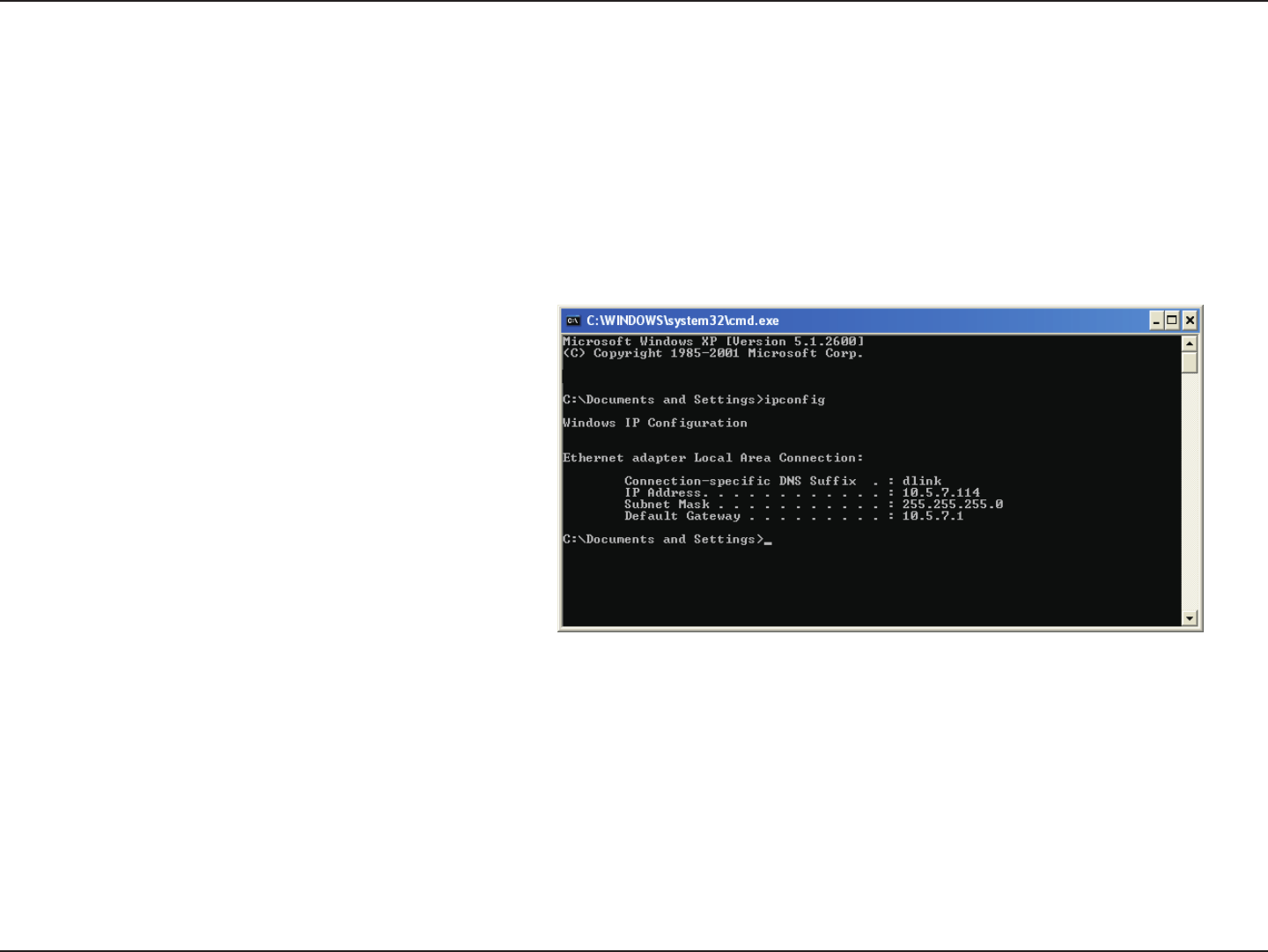
87D-Link DIR-619L User Manual
Appendix B - Networking Basics
Networking Basics
Check your IP address
After you install your new D-Link adapter, by default, the TCP/IP settings should be set to obtain an IP address from a DHCP
server (i.e. wireless router) automatically. To verify your IP address, please follow the steps below.
Click on Start > Run. In the run box type cmd and click OK.
At the prompt, type ipcong and press Enter.
This will display the IP address, subnet mask, and the
default gateway of your adapter.
If the address is 0.0.0.0, check your adapter installation,
security settings, and the settings on your router.
Some rewall software programs may block a DHCP
request on newly installed adapters.
If you are connecting to a wireless network at a
hotspot (e.g. hotel, coee shop, airport), please contact an employee or administrator to verify their wireless network settings.
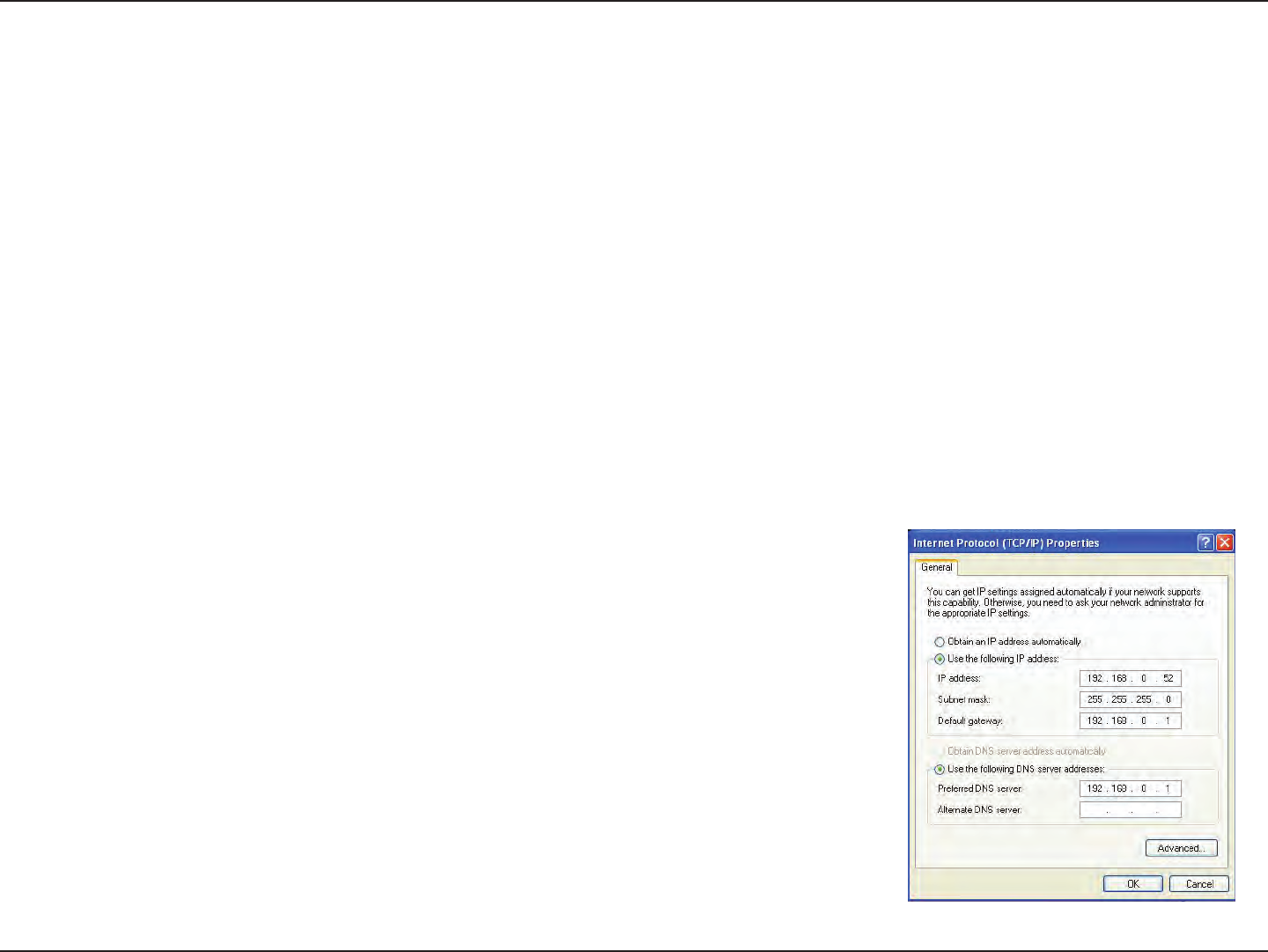
88D-Link DIR-619L User Manual
Appendix B - Networking Basics
Statically Assign an IP address
If you are not using a DHCP capable gateway/router, or you need to assign a static IP address, please follow the steps below:
Step 1
Windows® XP - Click on Start > Control Panel > Network Connections.
Windows® 2000 - From the desktop, right-click My Network Places > Properties.
Step 2
Right-click on the Local Area Connection which represents your D-Link network adapter and select Properties.
Step 3
Highlight Internet Protocol (TCP/IP) and click Properties.
Step 4
Click Use the following IP address and enter an IP address that is on the same subnet as your network or the LAN IP address
on your router.
Example: If the router´s LAN IP address is 192.168.0.1, make your IP address 192.168.0.X
where X is a number between 2 and 99. Make sure that the number you choose is not in
use on the network. Set Default Gateway the same as the LAN IP address of your router
(192.168.0.1).
Set Primary DNS the same as the LAN IP address of your router (192.168.0.1). The
Secondary DNS is not needed or you may enter a DNS server from your ISP.
Step 5
Click OK twice to save your settings.

89D-Link DIR-619L User Manual
Appendix C - Technical Specications
Technical Specications
Standards
• IEEE 802.11g
• IEEE 802.11b
• IEEE 802.11n
• IEEE 802.3
• IEEE 802.3u
• IEEE 802.3x
Wireless Signal Rates*
• 300Mbps • 150Mbps
• 54Mbps • 48Mbps
• 36Mbps • 24Mbps
• 18Mbps • 12Mbps
• 11Mbps • 9Mbps
• 6Mbps • 5.5Mbps
• 2Mbps • 1Mbps
Security
• WPA - Wi-Fi Protected Access (TKIP, MIC,
IV Expansion, Shared Key Authentication)
• 64/128-bit WEP
Modulation Technology
802.11 b : DSSS / DBPSK / DQPSK / CCK
802.11 g : 16QAM / 64QAM / BPSK / QPSK with OFDM
802.11 n : 16QAM / 64QAM / BPSK / QPSK with OFDM
VPN Pass Through/ Multi-Sessions
• PPTP
• IPSec
Device Management
• Web-based Internet Explorer 8 or later; Netscape
Navigator v6 or later; or other Java-enabled browsers
• DHCP Server and Client
Wireless Frequency Range
2.4GHz to 2.497GHz (802.11b)
2.4GHz to 2.4835GHZ (802.11g and 802.11n)
Wireless Operating Range2
• Indoors - up to 328 ft. (100 meters)
• Outdoors- up to 1312 ft. (400 meters)
Wireless Transmit Power (AVG Power)
11b:17dBm(Max) 11g:16dBm(Max) 11n:13dBm(Max)
External Antenna Type
Three xed external antenna
Advanced Firewall Features
• NAT with VPN Pass-through (Network Address Translation)
• MAC Filtering
• IP Filtering
• URL Filtering
• Scheduling
